Admission to the Intensive Care Unit Places Patients at Greater Risk of Developing Pressure Injuries
VerifiedAdded on 2023/05/29
|19
|5396
|456
AI Summary
This essay evaluates the connection between intensive care unit and pressure injuries, elaborates on the nature of the injuries and how to manage them.
Contribute Materials
Your contribution can guide someone’s learning journey. Share your
documents today.
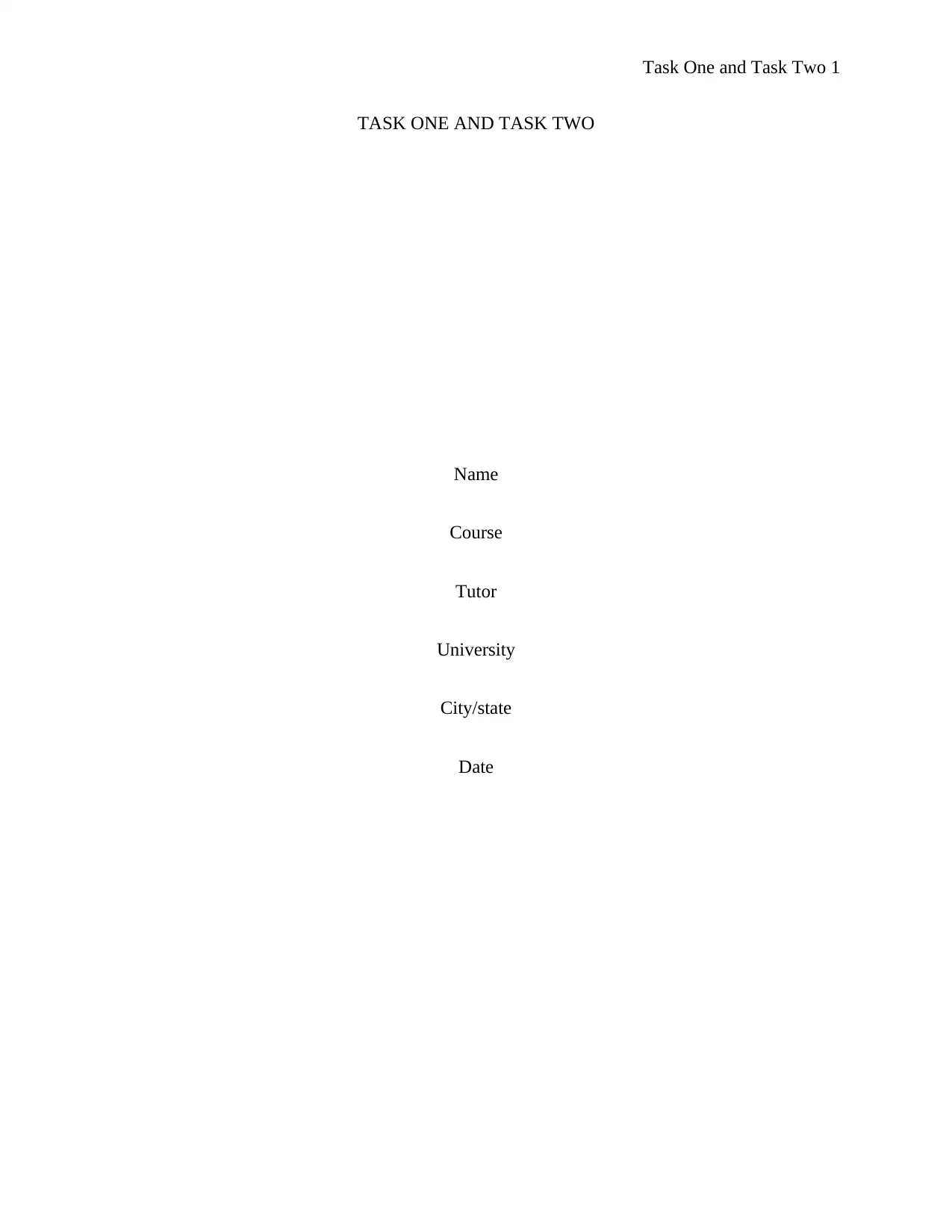
Task One and Task Two 1
TASK ONE AND TASK TWO
Name
Course
Tutor
University
City/state
Date
TASK ONE AND TASK TWO
Name
Course
Tutor
University
City/state
Date
Secure Best Marks with AI Grader
Need help grading? Try our AI Grader for instant feedback on your assignments.
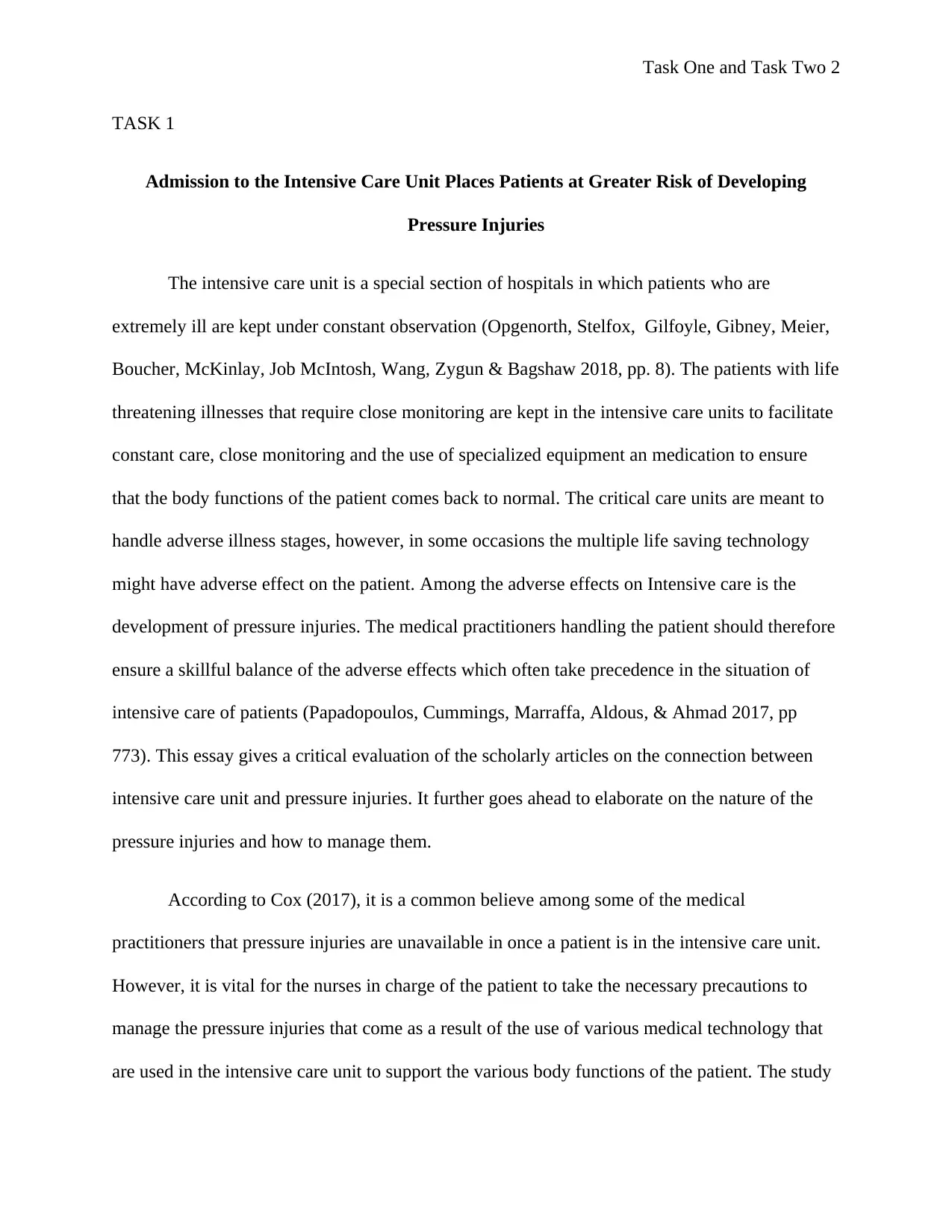
Task One and Task Two 2
TASK 1
Admission to the Intensive Care Unit Places Patients at Greater Risk of Developing
Pressure Injuries
The intensive care unit is a special section of hospitals in which patients who are
extremely ill are kept under constant observation (Opgenorth, Stelfox, Gilfoyle, Gibney, Meier,
Boucher, McKinlay, Job McIntosh, Wang, Zygun & Bagshaw 2018, pp. 8). The patients with life
threatening illnesses that require close monitoring are kept in the intensive care units to facilitate
constant care, close monitoring and the use of specialized equipment an medication to ensure
that the body functions of the patient comes back to normal. The critical care units are meant to
handle adverse illness stages, however, in some occasions the multiple life saving technology
might have adverse effect on the patient. Among the adverse effects on Intensive care is the
development of pressure injuries. The medical practitioners handling the patient should therefore
ensure a skillful balance of the adverse effects which often take precedence in the situation of
intensive care of patients (Papadopoulos, Cummings, Marraffa, Aldous, & Ahmad 2017, pp
773). This essay gives a critical evaluation of the scholarly articles on the connection between
intensive care unit and pressure injuries. It further goes ahead to elaborate on the nature of the
pressure injuries and how to manage them.
According to Cox (2017), it is a common believe among some of the medical
practitioners that pressure injuries are unavailable in once a patient is in the intensive care unit.
However, it is vital for the nurses in charge of the patient to take the necessary precautions to
manage the pressure injuries that come as a result of the use of various medical technology that
are used in the intensive care unit to support the various body functions of the patient. The study
TASK 1
Admission to the Intensive Care Unit Places Patients at Greater Risk of Developing
Pressure Injuries
The intensive care unit is a special section of hospitals in which patients who are
extremely ill are kept under constant observation (Opgenorth, Stelfox, Gilfoyle, Gibney, Meier,
Boucher, McKinlay, Job McIntosh, Wang, Zygun & Bagshaw 2018, pp. 8). The patients with life
threatening illnesses that require close monitoring are kept in the intensive care units to facilitate
constant care, close monitoring and the use of specialized equipment an medication to ensure
that the body functions of the patient comes back to normal. The critical care units are meant to
handle adverse illness stages, however, in some occasions the multiple life saving technology
might have adverse effect on the patient. Among the adverse effects on Intensive care is the
development of pressure injuries. The medical practitioners handling the patient should therefore
ensure a skillful balance of the adverse effects which often take precedence in the situation of
intensive care of patients (Papadopoulos, Cummings, Marraffa, Aldous, & Ahmad 2017, pp
773). This essay gives a critical evaluation of the scholarly articles on the connection between
intensive care unit and pressure injuries. It further goes ahead to elaborate on the nature of the
pressure injuries and how to manage them.
According to Cox (2017), it is a common believe among some of the medical
practitioners that pressure injuries are unavailable in once a patient is in the intensive care unit.
However, it is vital for the nurses in charge of the patient to take the necessary precautions to
manage the pressure injuries that come as a result of the use of various medical technology that
are used in the intensive care unit to support the various body functions of the patient. The study
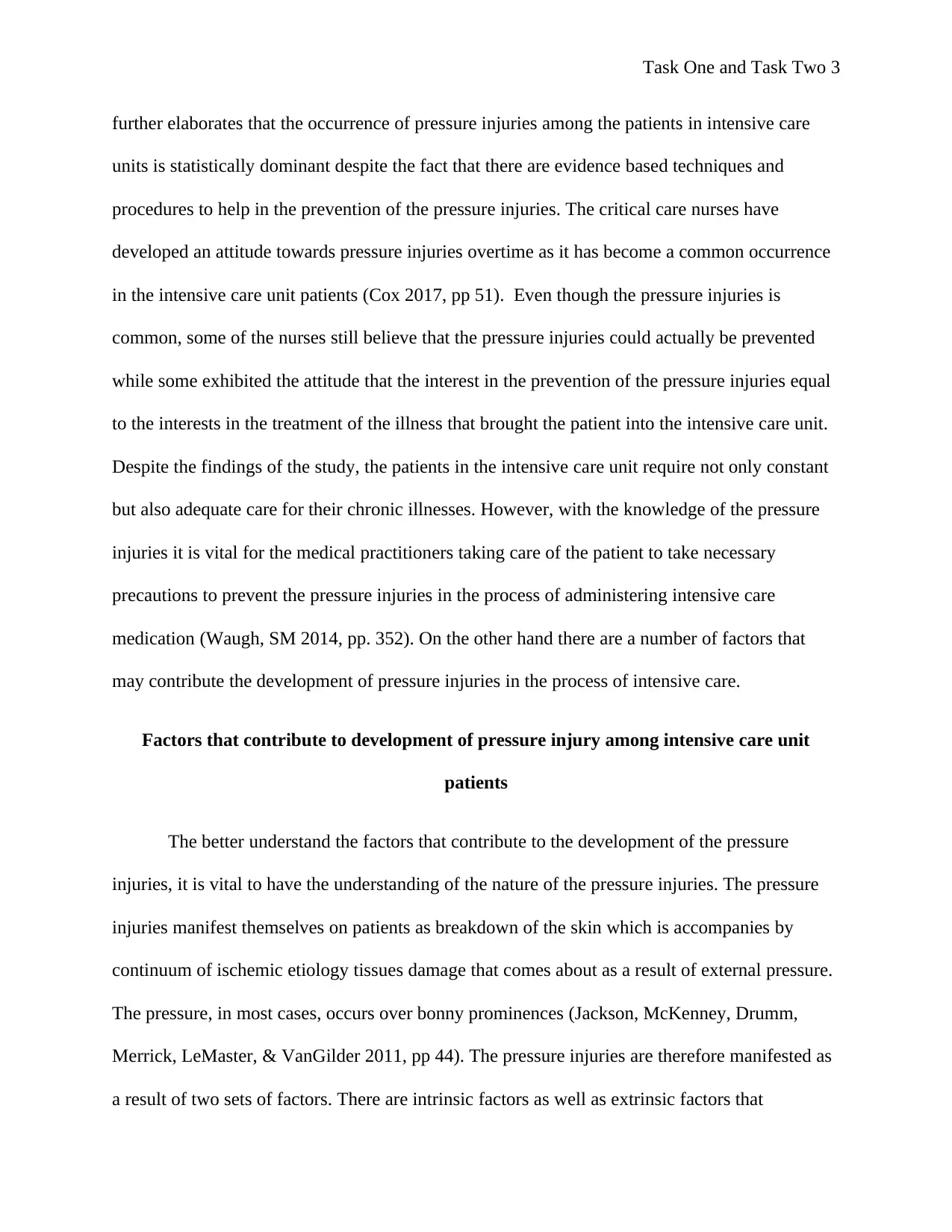
Task One and Task Two 3
further elaborates that the occurrence of pressure injuries among the patients in intensive care
units is statistically dominant despite the fact that there are evidence based techniques and
procedures to help in the prevention of the pressure injuries. The critical care nurses have
developed an attitude towards pressure injuries overtime as it has become a common occurrence
in the intensive care unit patients (Cox 2017, pp 51). Even though the pressure injuries is
common, some of the nurses still believe that the pressure injuries could actually be prevented
while some exhibited the attitude that the interest in the prevention of the pressure injuries equal
to the interests in the treatment of the illness that brought the patient into the intensive care unit.
Despite the findings of the study, the patients in the intensive care unit require not only constant
but also adequate care for their chronic illnesses. However, with the knowledge of the pressure
injuries it is vital for the medical practitioners taking care of the patient to take necessary
precautions to prevent the pressure injuries in the process of administering intensive care
medication (Waugh, SM 2014, pp. 352). On the other hand there are a number of factors that
may contribute the development of pressure injuries in the process of intensive care.
Factors that contribute to development of pressure injury among intensive care unit
patients
The better understand the factors that contribute to the development of the pressure
injuries, it is vital to have the understanding of the nature of the pressure injuries. The pressure
injuries manifest themselves on patients as breakdown of the skin which is accompanies by
continuum of ischemic etiology tissues damage that comes about as a result of external pressure.
The pressure, in most cases, occurs over bonny prominences (Jackson, McKenney, Drumm,
Merrick, LeMaster, & VanGilder 2011, pp 44). The pressure injuries are therefore manifested as
a result of two sets of factors. There are intrinsic factors as well as extrinsic factors that
further elaborates that the occurrence of pressure injuries among the patients in intensive care
units is statistically dominant despite the fact that there are evidence based techniques and
procedures to help in the prevention of the pressure injuries. The critical care nurses have
developed an attitude towards pressure injuries overtime as it has become a common occurrence
in the intensive care unit patients (Cox 2017, pp 51). Even though the pressure injuries is
common, some of the nurses still believe that the pressure injuries could actually be prevented
while some exhibited the attitude that the interest in the prevention of the pressure injuries equal
to the interests in the treatment of the illness that brought the patient into the intensive care unit.
Despite the findings of the study, the patients in the intensive care unit require not only constant
but also adequate care for their chronic illnesses. However, with the knowledge of the pressure
injuries it is vital for the medical practitioners taking care of the patient to take necessary
precautions to prevent the pressure injuries in the process of administering intensive care
medication (Waugh, SM 2014, pp. 352). On the other hand there are a number of factors that
may contribute the development of pressure injuries in the process of intensive care.
Factors that contribute to development of pressure injury among intensive care unit
patients
The better understand the factors that contribute to the development of the pressure
injuries, it is vital to have the understanding of the nature of the pressure injuries. The pressure
injuries manifest themselves on patients as breakdown of the skin which is accompanies by
continuum of ischemic etiology tissues damage that comes about as a result of external pressure.
The pressure, in most cases, occurs over bonny prominences (Jackson, McKenney, Drumm,
Merrick, LeMaster, & VanGilder 2011, pp 44). The pressure injuries are therefore manifested as
a result of two sets of factors. There are intrinsic factors as well as extrinsic factors that
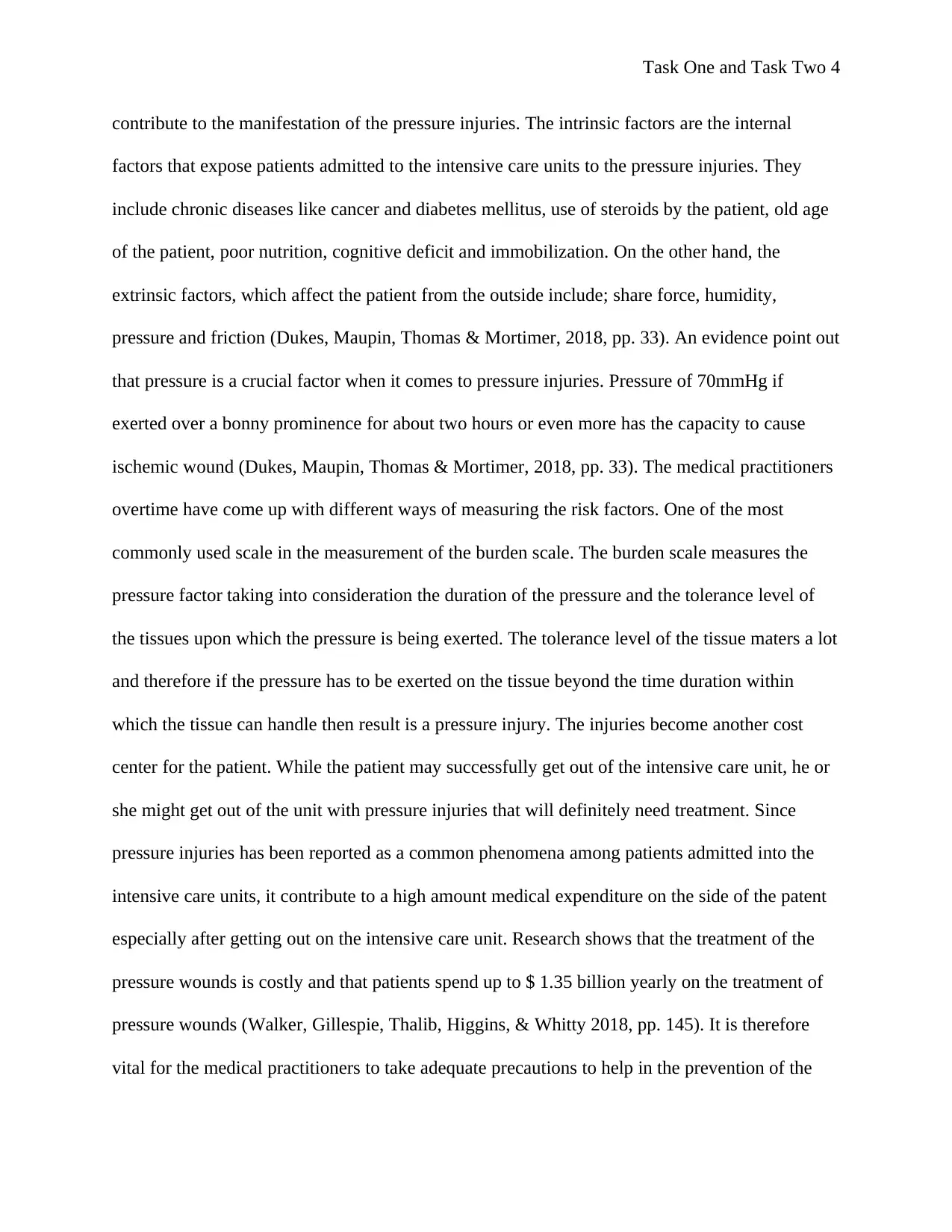
Task One and Task Two 4
contribute to the manifestation of the pressure injuries. The intrinsic factors are the internal
factors that expose patients admitted to the intensive care units to the pressure injuries. They
include chronic diseases like cancer and diabetes mellitus, use of steroids by the patient, old age
of the patient, poor nutrition, cognitive deficit and immobilization. On the other hand, the
extrinsic factors, which affect the patient from the outside include; share force, humidity,
pressure and friction (Dukes, Maupin, Thomas & Mortimer, 2018, pp. 33). An evidence point out
that pressure is a crucial factor when it comes to pressure injuries. Pressure of 70mmHg if
exerted over a bonny prominence for about two hours or even more has the capacity to cause
ischemic wound (Dukes, Maupin, Thomas & Mortimer, 2018, pp. 33). The medical practitioners
overtime have come up with different ways of measuring the risk factors. One of the most
commonly used scale in the measurement of the burden scale. The burden scale measures the
pressure factor taking into consideration the duration of the pressure and the tolerance level of
the tissues upon which the pressure is being exerted. The tolerance level of the tissue maters a lot
and therefore if the pressure has to be exerted on the tissue beyond the time duration within
which the tissue can handle then result is a pressure injury. The injuries become another cost
center for the patient. While the patient may successfully get out of the intensive care unit, he or
she might get out of the unit with pressure injuries that will definitely need treatment. Since
pressure injuries has been reported as a common phenomena among patients admitted into the
intensive care units, it contribute to a high amount medical expenditure on the side of the patent
especially after getting out on the intensive care unit. Research shows that the treatment of the
pressure wounds is costly and that patients spend up to $ 1.35 billion yearly on the treatment of
pressure wounds (Walker, Gillespie, Thalib, Higgins, & Whitty 2018, pp. 145). It is therefore
vital for the medical practitioners to take adequate precautions to help in the prevention of the
contribute to the manifestation of the pressure injuries. The intrinsic factors are the internal
factors that expose patients admitted to the intensive care units to the pressure injuries. They
include chronic diseases like cancer and diabetes mellitus, use of steroids by the patient, old age
of the patient, poor nutrition, cognitive deficit and immobilization. On the other hand, the
extrinsic factors, which affect the patient from the outside include; share force, humidity,
pressure and friction (Dukes, Maupin, Thomas & Mortimer, 2018, pp. 33). An evidence point out
that pressure is a crucial factor when it comes to pressure injuries. Pressure of 70mmHg if
exerted over a bonny prominence for about two hours or even more has the capacity to cause
ischemic wound (Dukes, Maupin, Thomas & Mortimer, 2018, pp. 33). The medical practitioners
overtime have come up with different ways of measuring the risk factors. One of the most
commonly used scale in the measurement of the burden scale. The burden scale measures the
pressure factor taking into consideration the duration of the pressure and the tolerance level of
the tissues upon which the pressure is being exerted. The tolerance level of the tissue maters a lot
and therefore if the pressure has to be exerted on the tissue beyond the time duration within
which the tissue can handle then result is a pressure injury. The injuries become another cost
center for the patient. While the patient may successfully get out of the intensive care unit, he or
she might get out of the unit with pressure injuries that will definitely need treatment. Since
pressure injuries has been reported as a common phenomena among patients admitted into the
intensive care units, it contribute to a high amount medical expenditure on the side of the patent
especially after getting out on the intensive care unit. Research shows that the treatment of the
pressure wounds is costly and that patients spend up to $ 1.35 billion yearly on the treatment of
pressure wounds (Walker, Gillespie, Thalib, Higgins, & Whitty 2018, pp. 145). It is therefore
vital for the medical practitioners to take adequate precautions to help in the prevention of the
Secure Best Marks with AI Grader
Need help grading? Try our AI Grader for instant feedback on your assignments.
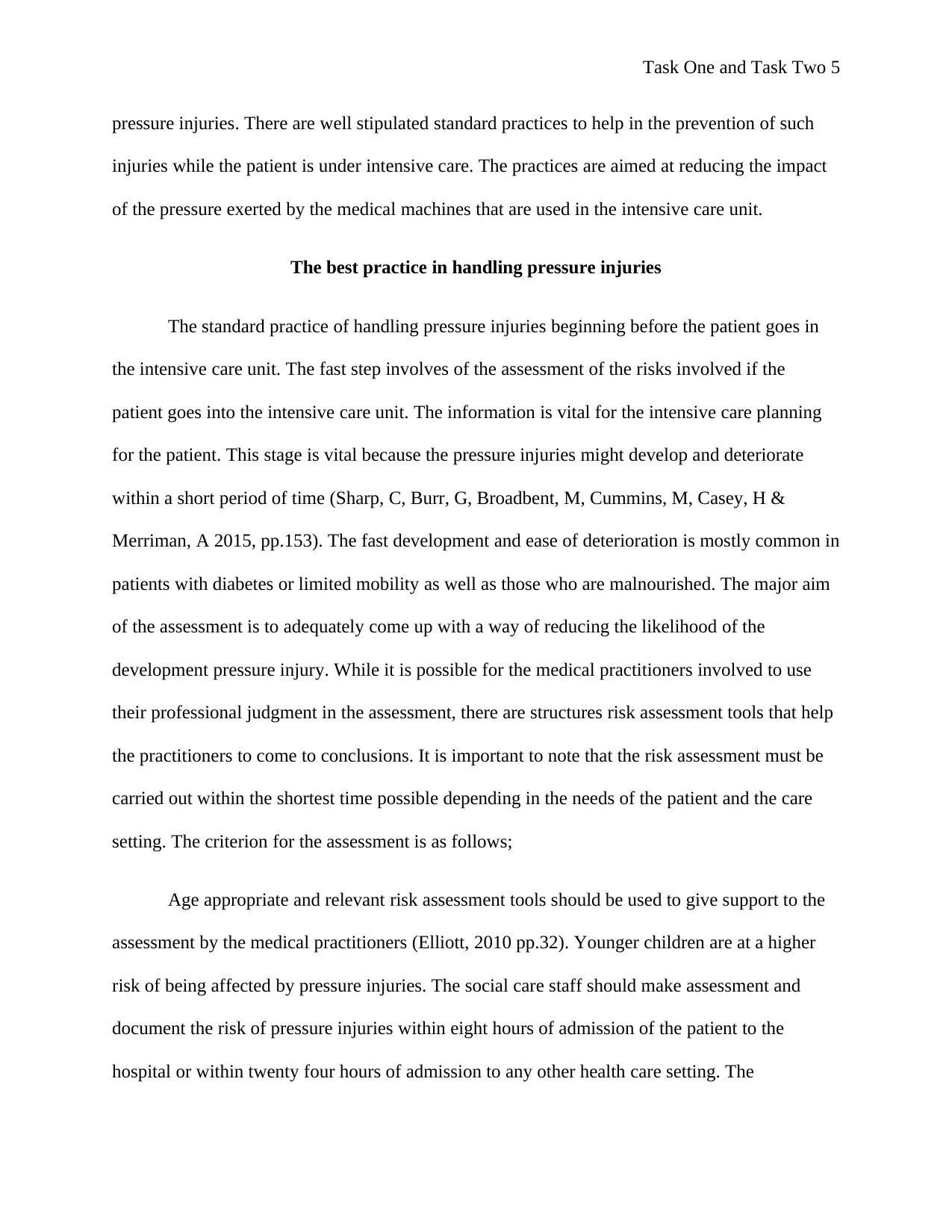
Task One and Task Two 5
pressure injuries. There are well stipulated standard practices to help in the prevention of such
injuries while the patient is under intensive care. The practices are aimed at reducing the impact
of the pressure exerted by the medical machines that are used in the intensive care unit.
The best practice in handling pressure injuries
The standard practice of handling pressure injuries beginning before the patient goes in
the intensive care unit. The fast step involves of the assessment of the risks involved if the
patient goes into the intensive care unit. The information is vital for the intensive care planning
for the patient. This stage is vital because the pressure injuries might develop and deteriorate
within a short period of time (Sharp, C, Burr, G, Broadbent, M, Cummins, M, Casey, H &
Merriman, A 2015, pp.153). The fast development and ease of deterioration is mostly common in
patients with diabetes or limited mobility as well as those who are malnourished. The major aim
of the assessment is to adequately come up with a way of reducing the likelihood of the
development pressure injury. While it is possible for the medical practitioners involved to use
their professional judgment in the assessment, there are structures risk assessment tools that help
the practitioners to come to conclusions. It is important to note that the risk assessment must be
carried out within the shortest time possible depending in the needs of the patient and the care
setting. The criterion for the assessment is as follows;
Age appropriate and relevant risk assessment tools should be used to give support to the
assessment by the medical practitioners (Elliott, 2010 pp.32). Younger children are at a higher
risk of being affected by pressure injuries. The social care staff should make assessment and
document the risk of pressure injuries within eight hours of admission of the patient to the
hospital or within twenty four hours of admission to any other health care setting. The
pressure injuries. There are well stipulated standard practices to help in the prevention of such
injuries while the patient is under intensive care. The practices are aimed at reducing the impact
of the pressure exerted by the medical machines that are used in the intensive care unit.
The best practice in handling pressure injuries
The standard practice of handling pressure injuries beginning before the patient goes in
the intensive care unit. The fast step involves of the assessment of the risks involved if the
patient goes into the intensive care unit. The information is vital for the intensive care planning
for the patient. This stage is vital because the pressure injuries might develop and deteriorate
within a short period of time (Sharp, C, Burr, G, Broadbent, M, Cummins, M, Casey, H &
Merriman, A 2015, pp.153). The fast development and ease of deterioration is mostly common in
patients with diabetes or limited mobility as well as those who are malnourished. The major aim
of the assessment is to adequately come up with a way of reducing the likelihood of the
development pressure injury. While it is possible for the medical practitioners involved to use
their professional judgment in the assessment, there are structures risk assessment tools that help
the practitioners to come to conclusions. It is important to note that the risk assessment must be
carried out within the shortest time possible depending in the needs of the patient and the care
setting. The criterion for the assessment is as follows;
Age appropriate and relevant risk assessment tools should be used to give support to the
assessment by the medical practitioners (Elliott, 2010 pp.32). Younger children are at a higher
risk of being affected by pressure injuries. The social care staff should make assessment and
document the risk of pressure injuries within eight hours of admission of the patient to the
hospital or within twenty four hours of admission to any other health care setting. The
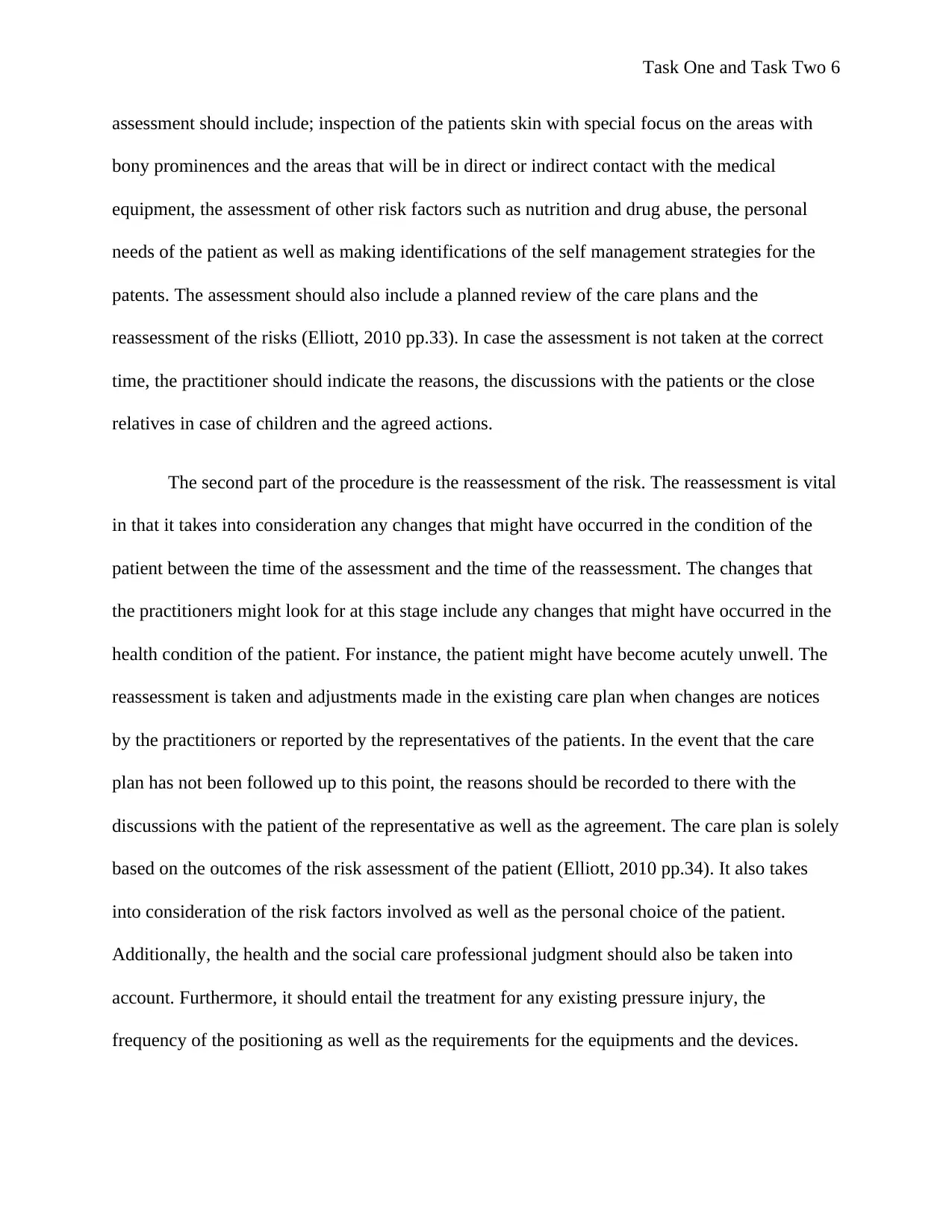
Task One and Task Two 6
assessment should include; inspection of the patients skin with special focus on the areas with
bony prominences and the areas that will be in direct or indirect contact with the medical
equipment, the assessment of other risk factors such as nutrition and drug abuse, the personal
needs of the patient as well as making identifications of the self management strategies for the
patents. The assessment should also include a planned review of the care plans and the
reassessment of the risks (Elliott, 2010 pp.33). In case the assessment is not taken at the correct
time, the practitioner should indicate the reasons, the discussions with the patients or the close
relatives in case of children and the agreed actions.
The second part of the procedure is the reassessment of the risk. The reassessment is vital
in that it takes into consideration any changes that might have occurred in the condition of the
patient between the time of the assessment and the time of the reassessment. The changes that
the practitioners might look for at this stage include any changes that might have occurred in the
health condition of the patient. For instance, the patient might have become acutely unwell. The
reassessment is taken and adjustments made in the existing care plan when changes are notices
by the practitioners or reported by the representatives of the patients. In the event that the care
plan has not been followed up to this point, the reasons should be recorded to there with the
discussions with the patient of the representative as well as the agreement. The care plan is solely
based on the outcomes of the risk assessment of the patient (Elliott, 2010 pp.34). It also takes
into consideration of the risk factors involved as well as the personal choice of the patient.
Additionally, the health and the social care professional judgment should also be taken into
account. Furthermore, it should entail the treatment for any existing pressure injury, the
frequency of the positioning as well as the requirements for the equipments and the devices.
assessment should include; inspection of the patients skin with special focus on the areas with
bony prominences and the areas that will be in direct or indirect contact with the medical
equipment, the assessment of other risk factors such as nutrition and drug abuse, the personal
needs of the patient as well as making identifications of the self management strategies for the
patents. The assessment should also include a planned review of the care plans and the
reassessment of the risks (Elliott, 2010 pp.33). In case the assessment is not taken at the correct
time, the practitioner should indicate the reasons, the discussions with the patients or the close
relatives in case of children and the agreed actions.
The second part of the procedure is the reassessment of the risk. The reassessment is vital
in that it takes into consideration any changes that might have occurred in the condition of the
patient between the time of the assessment and the time of the reassessment. The changes that
the practitioners might look for at this stage include any changes that might have occurred in the
health condition of the patient. For instance, the patient might have become acutely unwell. The
reassessment is taken and adjustments made in the existing care plan when changes are notices
by the practitioners or reported by the representatives of the patients. In the event that the care
plan has not been followed up to this point, the reasons should be recorded to there with the
discussions with the patient of the representative as well as the agreement. The care plan is solely
based on the outcomes of the risk assessment of the patient (Elliott, 2010 pp.34). It also takes
into consideration of the risk factors involved as well as the personal choice of the patient.
Additionally, the health and the social care professional judgment should also be taken into
account. Furthermore, it should entail the treatment for any existing pressure injury, the
frequency of the positioning as well as the requirements for the equipments and the devices.
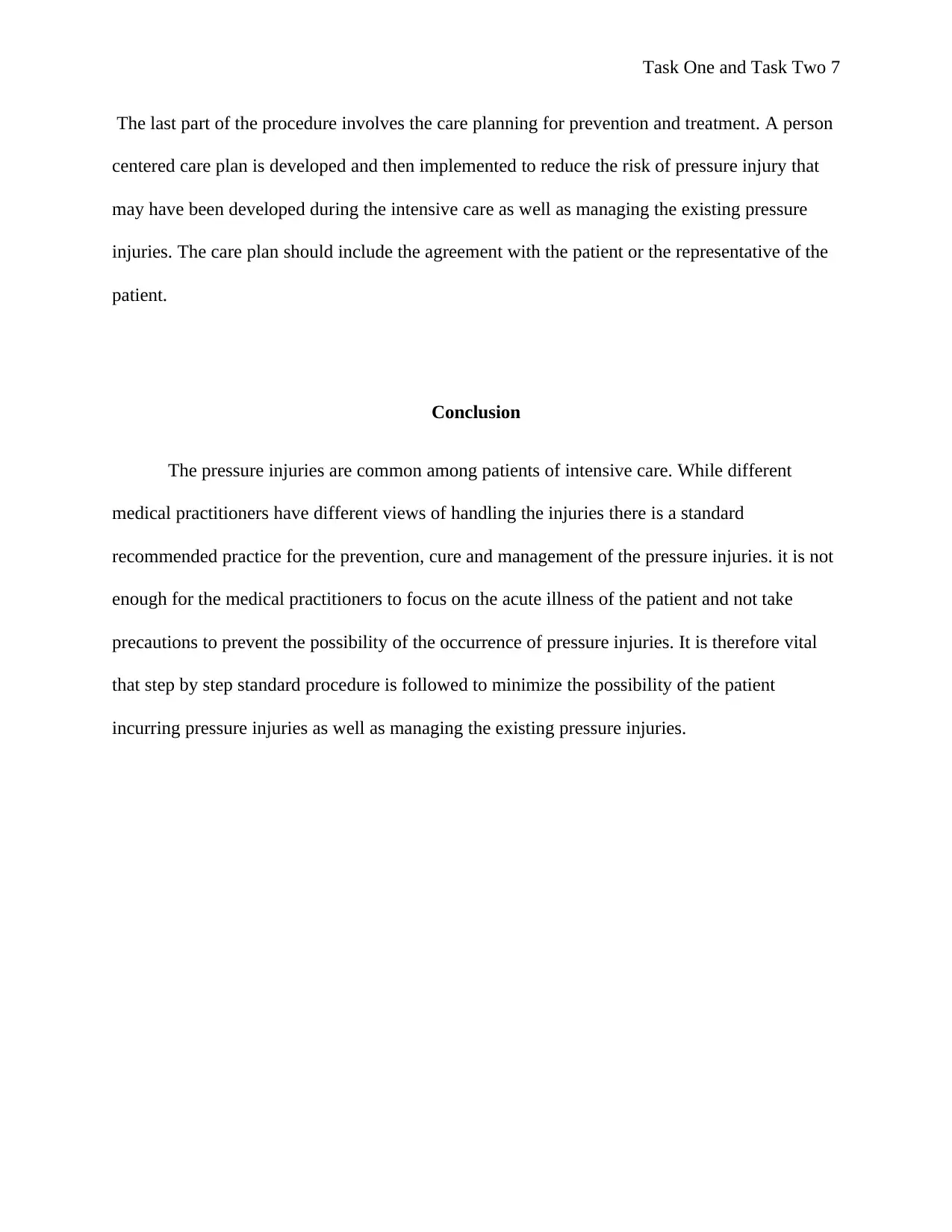
Task One and Task Two 7
The last part of the procedure involves the care planning for prevention and treatment. A person
centered care plan is developed and then implemented to reduce the risk of pressure injury that
may have been developed during the intensive care as well as managing the existing pressure
injuries. The care plan should include the agreement with the patient or the representative of the
patient.
Conclusion
The pressure injuries are common among patients of intensive care. While different
medical practitioners have different views of handling the injuries there is a standard
recommended practice for the prevention, cure and management of the pressure injuries. it is not
enough for the medical practitioners to focus on the acute illness of the patient and not take
precautions to prevent the possibility of the occurrence of pressure injuries. It is therefore vital
that step by step standard procedure is followed to minimize the possibility of the patient
incurring pressure injuries as well as managing the existing pressure injuries.
The last part of the procedure involves the care planning for prevention and treatment. A person
centered care plan is developed and then implemented to reduce the risk of pressure injury that
may have been developed during the intensive care as well as managing the existing pressure
injuries. The care plan should include the agreement with the patient or the representative of the
patient.
Conclusion
The pressure injuries are common among patients of intensive care. While different
medical practitioners have different views of handling the injuries there is a standard
recommended practice for the prevention, cure and management of the pressure injuries. it is not
enough for the medical practitioners to focus on the acute illness of the patient and not take
precautions to prevent the possibility of the occurrence of pressure injuries. It is therefore vital
that step by step standard procedure is followed to minimize the possibility of the patient
incurring pressure injuries as well as managing the existing pressure injuries.
Paraphrase This Document
Need a fresh take? Get an instant paraphrase of this document with our AI Paraphraser
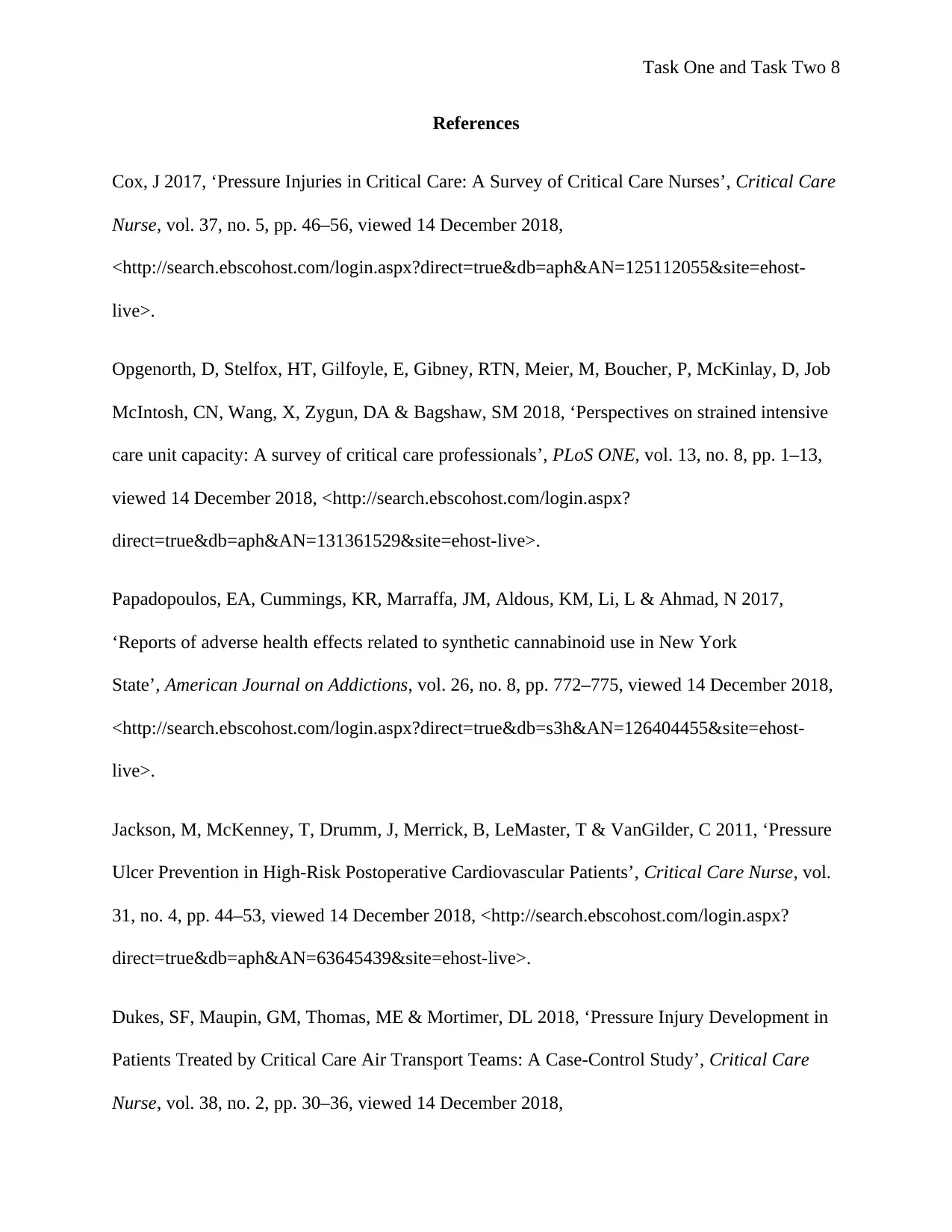
Task One and Task Two 8
References
Cox, J 2017, ‘Pressure Injuries in Critical Care: A Survey of Critical Care Nurses’, Critical Care
Nurse, vol. 37, no. 5, pp. 46–56, viewed 14 December 2018,
<http://search.ebscohost.com/login.aspx?direct=true&db=aph&AN=125112055&site=ehost-
live>.
Opgenorth, D, Stelfox, HT, Gilfoyle, E, Gibney, RTN, Meier, M, Boucher, P, McKinlay, D, Job
McIntosh, CN, Wang, X, Zygun, DA & Bagshaw, SM 2018, ‘Perspectives on strained intensive
care unit capacity: A survey of critical care professionals’, PLoS ONE, vol. 13, no. 8, pp. 1–13,
viewed 14 December 2018, <http://search.ebscohost.com/login.aspx?
direct=true&db=aph&AN=131361529&site=ehost-live>.
Papadopoulos, EA, Cummings, KR, Marraffa, JM, Aldous, KM, Li, L & Ahmad, N 2017,
‘Reports of adverse health effects related to synthetic cannabinoid use in New York
State’, American Journal on Addictions, vol. 26, no. 8, pp. 772–775, viewed 14 December 2018,
<http://search.ebscohost.com/login.aspx?direct=true&db=s3h&AN=126404455&site=ehost-
live>.
Jackson, M, McKenney, T, Drumm, J, Merrick, B, LeMaster, T & VanGilder, C 2011, ‘Pressure
Ulcer Prevention in High-Risk Postoperative Cardiovascular Patients’, Critical Care Nurse, vol.
31, no. 4, pp. 44–53, viewed 14 December 2018, <http://search.ebscohost.com/login.aspx?
direct=true&db=aph&AN=63645439&site=ehost-live>.
Dukes, SF, Maupin, GM, Thomas, ME & Mortimer, DL 2018, ‘Pressure Injury Development in
Patients Treated by Critical Care Air Transport Teams: A Case-Control Study’, Critical Care
Nurse, vol. 38, no. 2, pp. 30–36, viewed 14 December 2018,
References
Cox, J 2017, ‘Pressure Injuries in Critical Care: A Survey of Critical Care Nurses’, Critical Care
Nurse, vol. 37, no. 5, pp. 46–56, viewed 14 December 2018,
<http://search.ebscohost.com/login.aspx?direct=true&db=aph&AN=125112055&site=ehost-
live>.
Opgenorth, D, Stelfox, HT, Gilfoyle, E, Gibney, RTN, Meier, M, Boucher, P, McKinlay, D, Job
McIntosh, CN, Wang, X, Zygun, DA & Bagshaw, SM 2018, ‘Perspectives on strained intensive
care unit capacity: A survey of critical care professionals’, PLoS ONE, vol. 13, no. 8, pp. 1–13,
viewed 14 December 2018, <http://search.ebscohost.com/login.aspx?
direct=true&db=aph&AN=131361529&site=ehost-live>.
Papadopoulos, EA, Cummings, KR, Marraffa, JM, Aldous, KM, Li, L & Ahmad, N 2017,
‘Reports of adverse health effects related to synthetic cannabinoid use in New York
State’, American Journal on Addictions, vol. 26, no. 8, pp. 772–775, viewed 14 December 2018,
<http://search.ebscohost.com/login.aspx?direct=true&db=s3h&AN=126404455&site=ehost-
live>.
Jackson, M, McKenney, T, Drumm, J, Merrick, B, LeMaster, T & VanGilder, C 2011, ‘Pressure
Ulcer Prevention in High-Risk Postoperative Cardiovascular Patients’, Critical Care Nurse, vol.
31, no. 4, pp. 44–53, viewed 14 December 2018, <http://search.ebscohost.com/login.aspx?
direct=true&db=aph&AN=63645439&site=ehost-live>.
Dukes, SF, Maupin, GM, Thomas, ME & Mortimer, DL 2018, ‘Pressure Injury Development in
Patients Treated by Critical Care Air Transport Teams: A Case-Control Study’, Critical Care
Nurse, vol. 38, no. 2, pp. 30–36, viewed 14 December 2018,
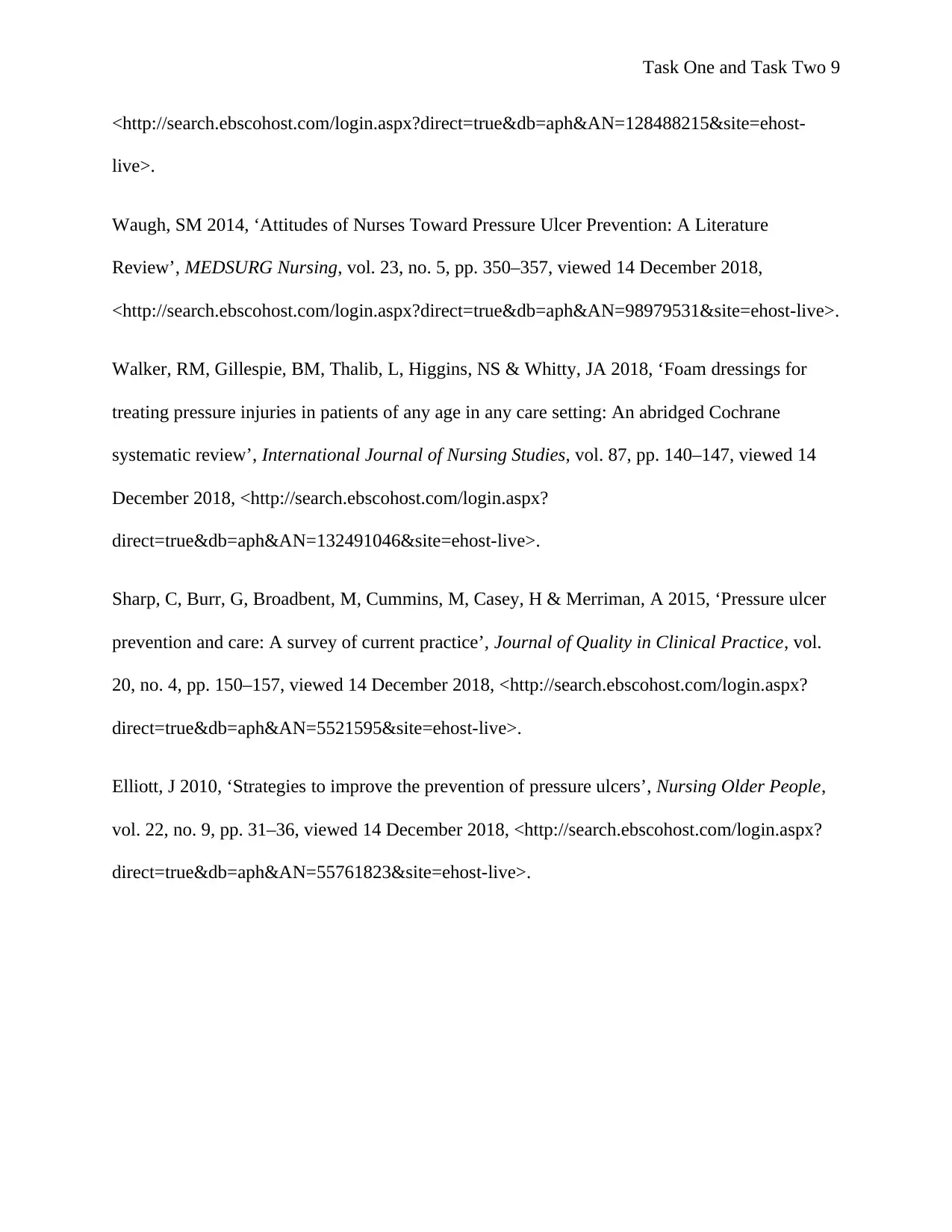
Task One and Task Two 9
<http://search.ebscohost.com/login.aspx?direct=true&db=aph&AN=128488215&site=ehost-
live>.
Waugh, SM 2014, ‘Attitudes of Nurses Toward Pressure Ulcer Prevention: A Literature
Review’, MEDSURG Nursing, vol. 23, no. 5, pp. 350–357, viewed 14 December 2018,
<http://search.ebscohost.com/login.aspx?direct=true&db=aph&AN=98979531&site=ehost-live>.
Walker, RM, Gillespie, BM, Thalib, L, Higgins, NS & Whitty, JA 2018, ‘Foam dressings for
treating pressure injuries in patients of any age in any care setting: An abridged Cochrane
systematic review’, International Journal of Nursing Studies, vol. 87, pp. 140–147, viewed 14
December 2018, <http://search.ebscohost.com/login.aspx?
direct=true&db=aph&AN=132491046&site=ehost-live>.
Sharp, C, Burr, G, Broadbent, M, Cummins, M, Casey, H & Merriman, A 2015, ‘Pressure ulcer
prevention and care: A survey of current practice’, Journal of Quality in Clinical Practice, vol.
20, no. 4, pp. 150–157, viewed 14 December 2018, <http://search.ebscohost.com/login.aspx?
direct=true&db=aph&AN=5521595&site=ehost-live>.
Elliott, J 2010, ‘Strategies to improve the prevention of pressure ulcers’, Nursing Older People,
vol. 22, no. 9, pp. 31–36, viewed 14 December 2018, <http://search.ebscohost.com/login.aspx?
direct=true&db=aph&AN=55761823&site=ehost-live>.
<http://search.ebscohost.com/login.aspx?direct=true&db=aph&AN=128488215&site=ehost-
live>.
Waugh, SM 2014, ‘Attitudes of Nurses Toward Pressure Ulcer Prevention: A Literature
Review’, MEDSURG Nursing, vol. 23, no. 5, pp. 350–357, viewed 14 December 2018,
<http://search.ebscohost.com/login.aspx?direct=true&db=aph&AN=98979531&site=ehost-live>.
Walker, RM, Gillespie, BM, Thalib, L, Higgins, NS & Whitty, JA 2018, ‘Foam dressings for
treating pressure injuries in patients of any age in any care setting: An abridged Cochrane
systematic review’, International Journal of Nursing Studies, vol. 87, pp. 140–147, viewed 14
December 2018, <http://search.ebscohost.com/login.aspx?
direct=true&db=aph&AN=132491046&site=ehost-live>.
Sharp, C, Burr, G, Broadbent, M, Cummins, M, Casey, H & Merriman, A 2015, ‘Pressure ulcer
prevention and care: A survey of current practice’, Journal of Quality in Clinical Practice, vol.
20, no. 4, pp. 150–157, viewed 14 December 2018, <http://search.ebscohost.com/login.aspx?
direct=true&db=aph&AN=5521595&site=ehost-live>.
Elliott, J 2010, ‘Strategies to improve the prevention of pressure ulcers’, Nursing Older People,
vol. 22, no. 9, pp. 31–36, viewed 14 December 2018, <http://search.ebscohost.com/login.aspx?
direct=true&db=aph&AN=55761823&site=ehost-live>.
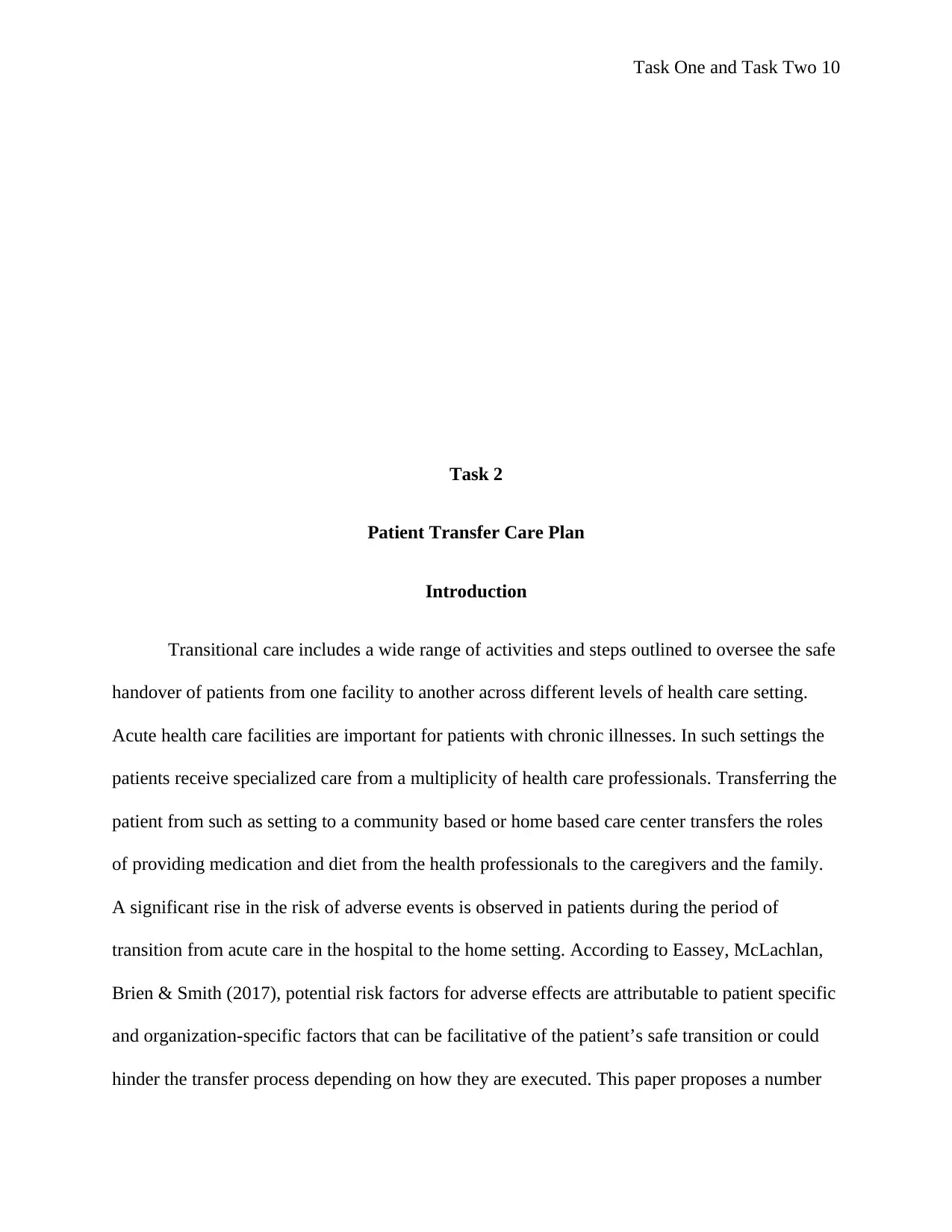
Task One and Task Two 10
Task 2
Patient Transfer Care Plan
Introduction
Transitional care includes a wide range of activities and steps outlined to oversee the safe
handover of patients from one facility to another across different levels of health care setting.
Acute health care facilities are important for patients with chronic illnesses. In such settings the
patients receive specialized care from a multiplicity of health care professionals. Transferring the
patient from such as setting to a community based or home based care center transfers the roles
of providing medication and diet from the health professionals to the caregivers and the family.
A significant rise in the risk of adverse events is observed in patients during the period of
transition from acute care in the hospital to the home setting. According to Eassey, McLachlan,
Brien & Smith (2017), potential risk factors for adverse effects are attributable to patient specific
and organization-specific factors that can be facilitative of the patient’s safe transition or could
hinder the transfer process depending on how they are executed. This paper proposes a number
Task 2
Patient Transfer Care Plan
Introduction
Transitional care includes a wide range of activities and steps outlined to oversee the safe
handover of patients from one facility to another across different levels of health care setting.
Acute health care facilities are important for patients with chronic illnesses. In such settings the
patients receive specialized care from a multiplicity of health care professionals. Transferring the
patient from such as setting to a community based or home based care center transfers the roles
of providing medication and diet from the health professionals to the caregivers and the family.
A significant rise in the risk of adverse events is observed in patients during the period of
transition from acute care in the hospital to the home setting. According to Eassey, McLachlan,
Brien & Smith (2017), potential risk factors for adverse effects are attributable to patient specific
and organization-specific factors that can be facilitative of the patient’s safe transition or could
hinder the transfer process depending on how they are executed. This paper proposes a number
Secure Best Marks with AI Grader
Need help grading? Try our AI Grader for instant feedback on your assignments.
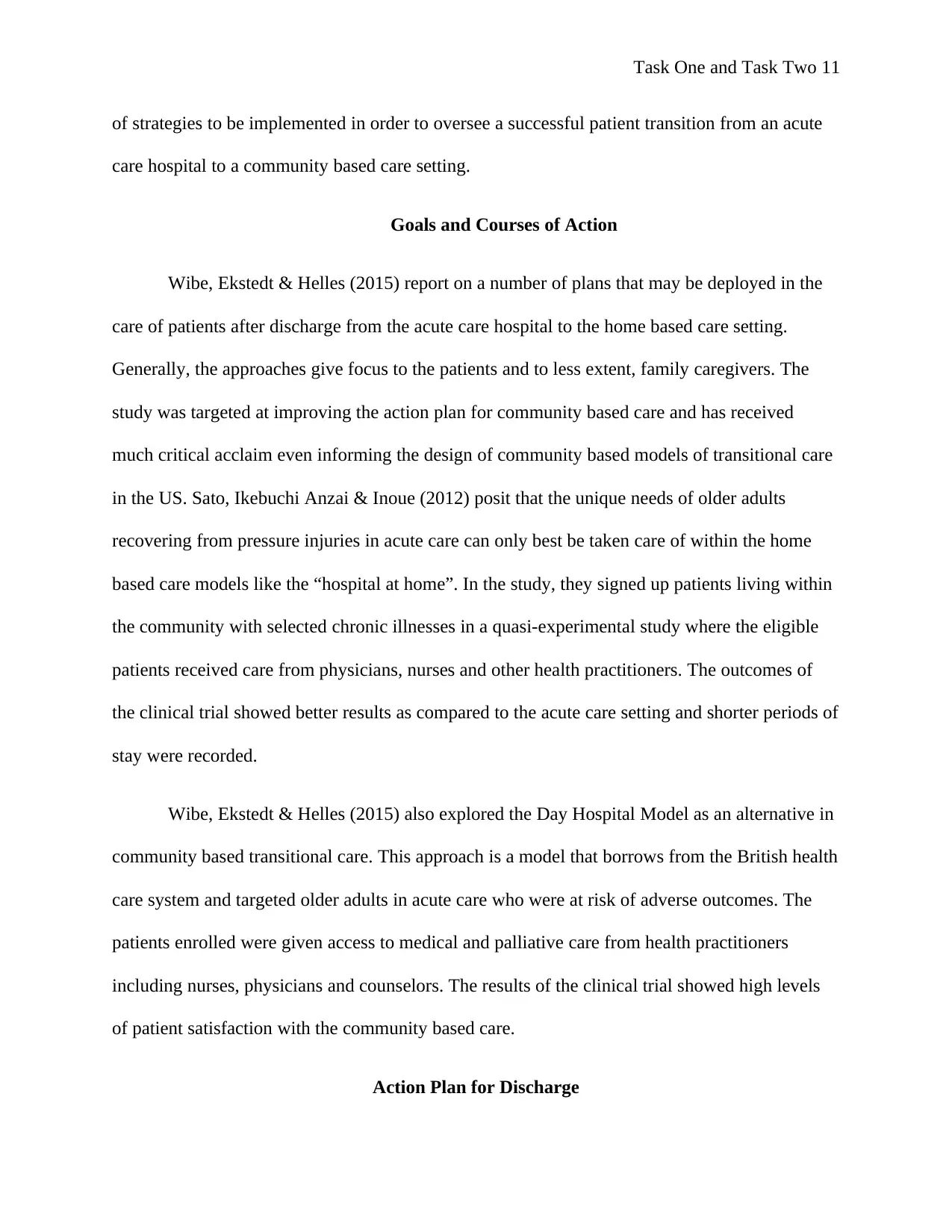
Task One and Task Two 11
of strategies to be implemented in order to oversee a successful patient transition from an acute
care hospital to a community based care setting.
Goals and Courses of Action
Wibe, Ekstedt & Helles (2015) report on a number of plans that may be deployed in the
care of patients after discharge from the acute care hospital to the home based care setting.
Generally, the approaches give focus to the patients and to less extent, family caregivers. The
study was targeted at improving the action plan for community based care and has received
much critical acclaim even informing the design of community based models of transitional care
in the US. Sato, Ikebuchi Anzai & Inoue (2012) posit that the unique needs of older adults
recovering from pressure injuries in acute care can only best be taken care of within the home
based care models like the “hospital at home”. In the study, they signed up patients living within
the community with selected chronic illnesses in a quasi-experimental study where the eligible
patients received care from physicians, nurses and other health practitioners. The outcomes of
the clinical trial showed better results as compared to the acute care setting and shorter periods of
stay were recorded.
Wibe, Ekstedt & Helles (2015) also explored the Day Hospital Model as an alternative in
community based transitional care. This approach is a model that borrows from the British health
care system and targeted older adults in acute care who were at risk of adverse outcomes. The
patients enrolled were given access to medical and palliative care from health practitioners
including nurses, physicians and counselors. The results of the clinical trial showed high levels
of patient satisfaction with the community based care.
Action Plan for Discharge
of strategies to be implemented in order to oversee a successful patient transition from an acute
care hospital to a community based care setting.
Goals and Courses of Action
Wibe, Ekstedt & Helles (2015) report on a number of plans that may be deployed in the
care of patients after discharge from the acute care hospital to the home based care setting.
Generally, the approaches give focus to the patients and to less extent, family caregivers. The
study was targeted at improving the action plan for community based care and has received
much critical acclaim even informing the design of community based models of transitional care
in the US. Sato, Ikebuchi Anzai & Inoue (2012) posit that the unique needs of older adults
recovering from pressure injuries in acute care can only best be taken care of within the home
based care models like the “hospital at home”. In the study, they signed up patients living within
the community with selected chronic illnesses in a quasi-experimental study where the eligible
patients received care from physicians, nurses and other health practitioners. The outcomes of
the clinical trial showed better results as compared to the acute care setting and shorter periods of
stay were recorded.
Wibe, Ekstedt & Helles (2015) also explored the Day Hospital Model as an alternative in
community based transitional care. This approach is a model that borrows from the British health
care system and targeted older adults in acute care who were at risk of adverse outcomes. The
patients enrolled were given access to medical and palliative care from health practitioners
including nurses, physicians and counselors. The results of the clinical trial showed high levels
of patient satisfaction with the community based care.
Action Plan for Discharge
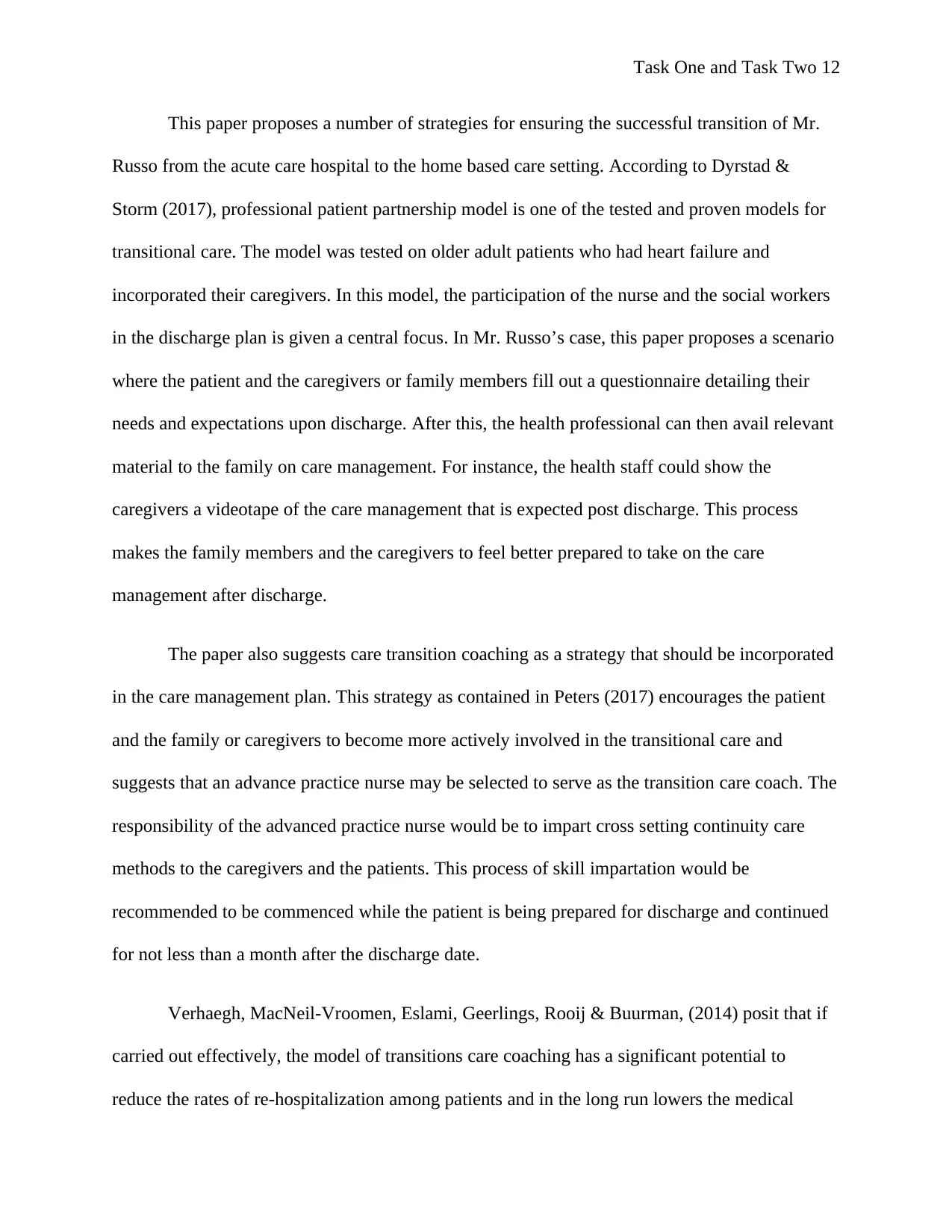
Task One and Task Two 12
This paper proposes a number of strategies for ensuring the successful transition of Mr.
Russo from the acute care hospital to the home based care setting. According to Dyrstad &
Storm (2017), professional patient partnership model is one of the tested and proven models for
transitional care. The model was tested on older adult patients who had heart failure and
incorporated their caregivers. In this model, the participation of the nurse and the social workers
in the discharge plan is given a central focus. In Mr. Russo’s case, this paper proposes a scenario
where the patient and the caregivers or family members fill out a questionnaire detailing their
needs and expectations upon discharge. After this, the health professional can then avail relevant
material to the family on care management. For instance, the health staff could show the
caregivers a videotape of the care management that is expected post discharge. This process
makes the family members and the caregivers to feel better prepared to take on the care
management after discharge.
The paper also suggests care transition coaching as a strategy that should be incorporated
in the care management plan. This strategy as contained in Peters (2017) encourages the patient
and the family or caregivers to become more actively involved in the transitional care and
suggests that an advance practice nurse may be selected to serve as the transition care coach. The
responsibility of the advanced practice nurse would be to impart cross setting continuity care
methods to the caregivers and the patients. This process of skill impartation would be
recommended to be commenced while the patient is being prepared for discharge and continued
for not less than a month after the discharge date.
Verhaegh, MacNeil-Vroomen, Eslami, Geerlings, Rooij & Buurman, (2014) posit that if
carried out effectively, the model of transitions care coaching has a significant potential to
reduce the rates of re-hospitalization among patients and in the long run lowers the medical
This paper proposes a number of strategies for ensuring the successful transition of Mr.
Russo from the acute care hospital to the home based care setting. According to Dyrstad &
Storm (2017), professional patient partnership model is one of the tested and proven models for
transitional care. The model was tested on older adult patients who had heart failure and
incorporated their caregivers. In this model, the participation of the nurse and the social workers
in the discharge plan is given a central focus. In Mr. Russo’s case, this paper proposes a scenario
where the patient and the caregivers or family members fill out a questionnaire detailing their
needs and expectations upon discharge. After this, the health professional can then avail relevant
material to the family on care management. For instance, the health staff could show the
caregivers a videotape of the care management that is expected post discharge. This process
makes the family members and the caregivers to feel better prepared to take on the care
management after discharge.
The paper also suggests care transition coaching as a strategy that should be incorporated
in the care management plan. This strategy as contained in Peters (2017) encourages the patient
and the family or caregivers to become more actively involved in the transitional care and
suggests that an advance practice nurse may be selected to serve as the transition care coach. The
responsibility of the advanced practice nurse would be to impart cross setting continuity care
methods to the caregivers and the patients. This process of skill impartation would be
recommended to be commenced while the patient is being prepared for discharge and continued
for not less than a month after the discharge date.
Verhaegh, MacNeil-Vroomen, Eslami, Geerlings, Rooij & Buurman, (2014) posit that if
carried out effectively, the model of transitions care coaching has a significant potential to
reduce the rates of re-hospitalization among patients and in the long run lowers the medical
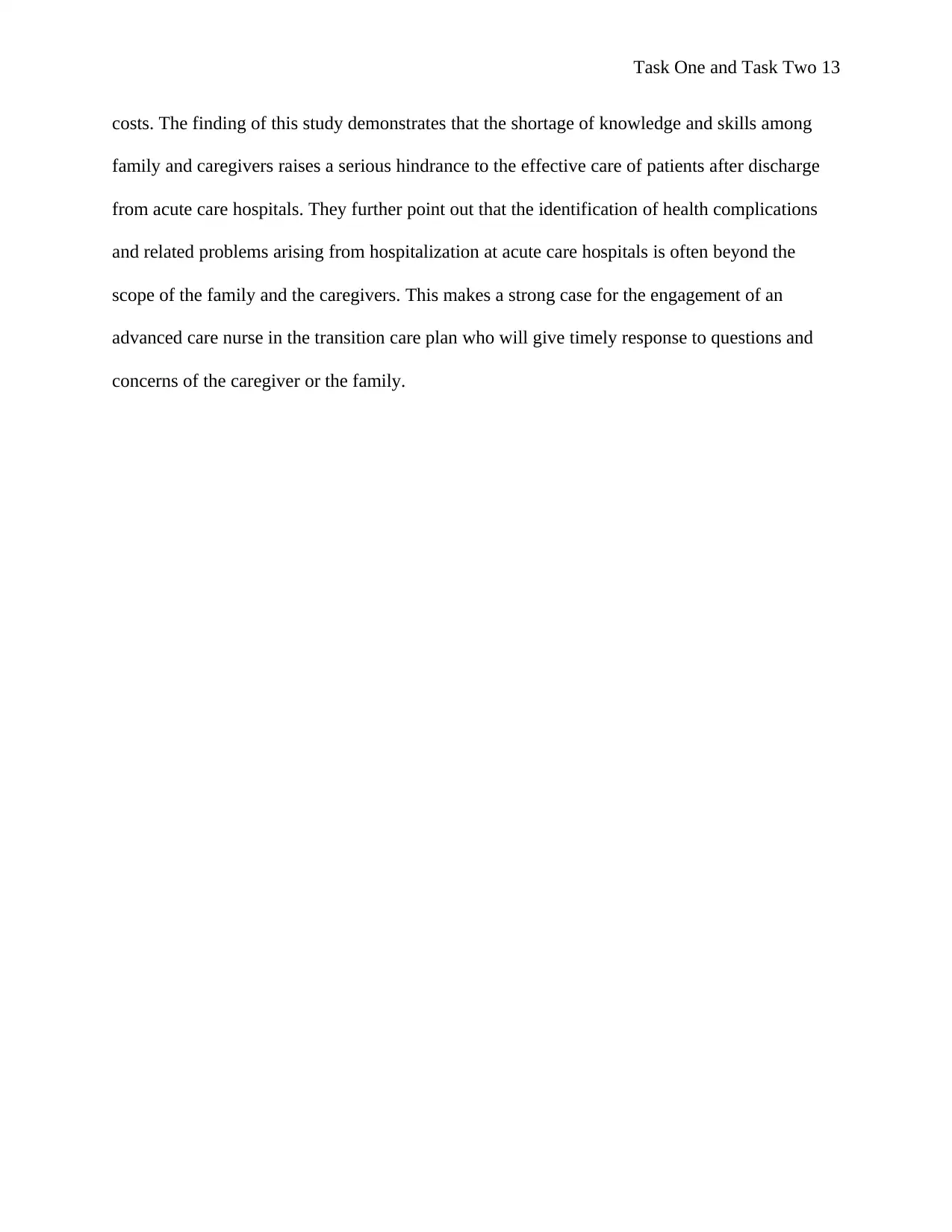
Task One and Task Two 13
costs. The finding of this study demonstrates that the shortage of knowledge and skills among
family and caregivers raises a serious hindrance to the effective care of patients after discharge
from acute care hospitals. They further point out that the identification of health complications
and related problems arising from hospitalization at acute care hospitals is often beyond the
scope of the family and the caregivers. This makes a strong case for the engagement of an
advanced care nurse in the transition care plan who will give timely response to questions and
concerns of the caregiver or the family.
costs. The finding of this study demonstrates that the shortage of knowledge and skills among
family and caregivers raises a serious hindrance to the effective care of patients after discharge
from acute care hospitals. They further point out that the identification of health complications
and related problems arising from hospitalization at acute care hospitals is often beyond the
scope of the family and the caregivers. This makes a strong case for the engagement of an
advanced care nurse in the transition care plan who will give timely response to questions and
concerns of the caregiver or the family.
Paraphrase This Document
Need a fresh take? Get an instant paraphrase of this document with our AI Paraphraser
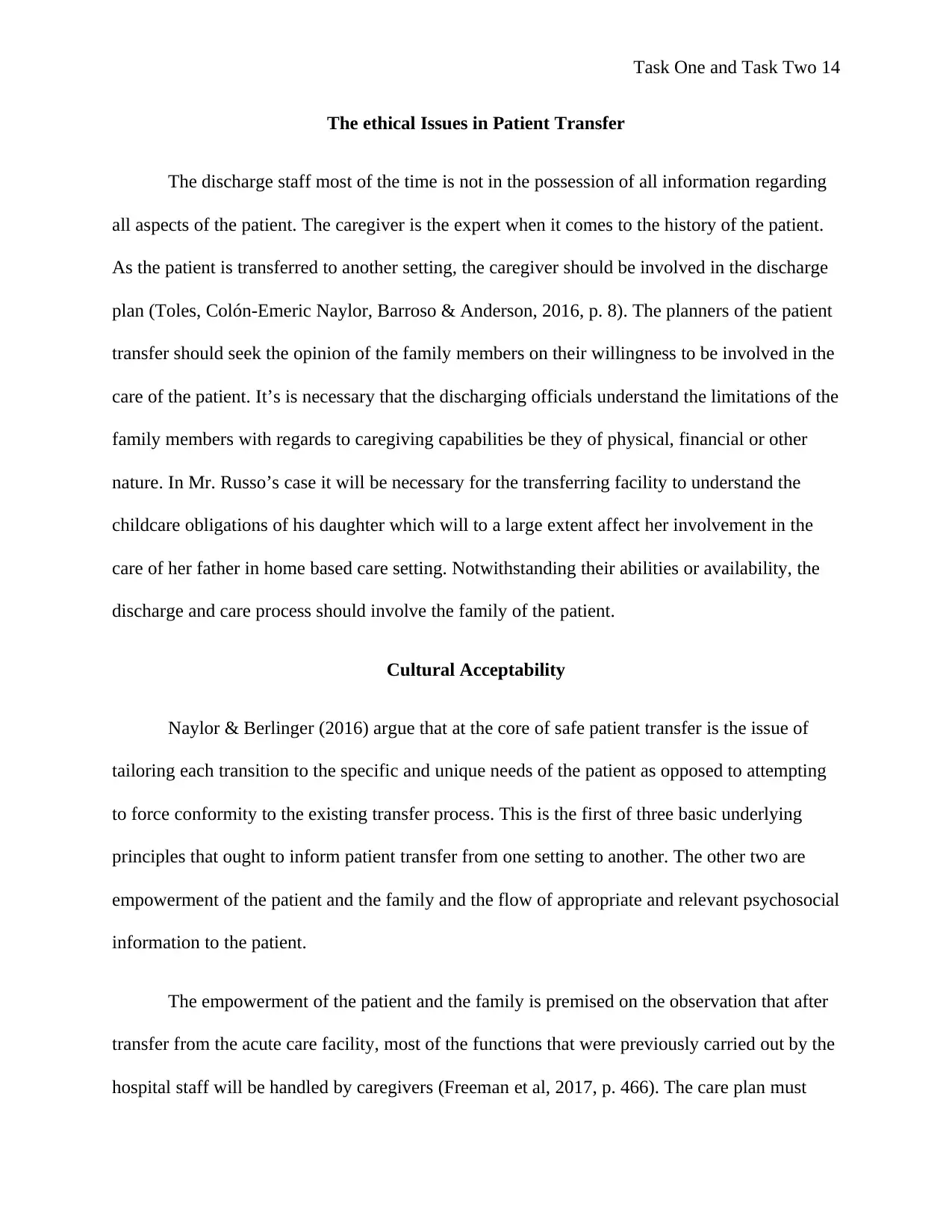
Task One and Task Two 14
The ethical Issues in Patient Transfer
The discharge staff most of the time is not in the possession of all information regarding
all aspects of the patient. The caregiver is the expert when it comes to the history of the patient.
As the patient is transferred to another setting, the caregiver should be involved in the discharge
plan (Toles, Colón-Emeric Naylor, Barroso & Anderson, 2016, p. 8). The planners of the patient
transfer should seek the opinion of the family members on their willingness to be involved in the
care of the patient. It’s is necessary that the discharging officials understand the limitations of the
family members with regards to caregiving capabilities be they of physical, financial or other
nature. In Mr. Russo’s case it will be necessary for the transferring facility to understand the
childcare obligations of his daughter which will to a large extent affect her involvement in the
care of her father in home based care setting. Notwithstanding their abilities or availability, the
discharge and care process should involve the family of the patient.
Cultural Acceptability
Naylor & Berlinger (2016) argue that at the core of safe patient transfer is the issue of
tailoring each transition to the specific and unique needs of the patient as opposed to attempting
to force conformity to the existing transfer process. This is the first of three basic underlying
principles that ought to inform patient transfer from one setting to another. The other two are
empowerment of the patient and the family and the flow of appropriate and relevant psychosocial
information to the patient.
The empowerment of the patient and the family is premised on the observation that after
transfer from the acute care facility, most of the functions that were previously carried out by the
hospital staff will be handled by caregivers (Freeman et al, 2017, p. 466). The care plan must
The ethical Issues in Patient Transfer
The discharge staff most of the time is not in the possession of all information regarding
all aspects of the patient. The caregiver is the expert when it comes to the history of the patient.
As the patient is transferred to another setting, the caregiver should be involved in the discharge
plan (Toles, Colón-Emeric Naylor, Barroso & Anderson, 2016, p. 8). The planners of the patient
transfer should seek the opinion of the family members on their willingness to be involved in the
care of the patient. It’s is necessary that the discharging officials understand the limitations of the
family members with regards to caregiving capabilities be they of physical, financial or other
nature. In Mr. Russo’s case it will be necessary for the transferring facility to understand the
childcare obligations of his daughter which will to a large extent affect her involvement in the
care of her father in home based care setting. Notwithstanding their abilities or availability, the
discharge and care process should involve the family of the patient.
Cultural Acceptability
Naylor & Berlinger (2016) argue that at the core of safe patient transfer is the issue of
tailoring each transition to the specific and unique needs of the patient as opposed to attempting
to force conformity to the existing transfer process. This is the first of three basic underlying
principles that ought to inform patient transfer from one setting to another. The other two are
empowerment of the patient and the family and the flow of appropriate and relevant psychosocial
information to the patient.
The empowerment of the patient and the family is premised on the observation that after
transfer from the acute care facility, most of the functions that were previously carried out by the
hospital staff will be handled by caregivers (Freeman et al, 2017, p. 466). The care plan must
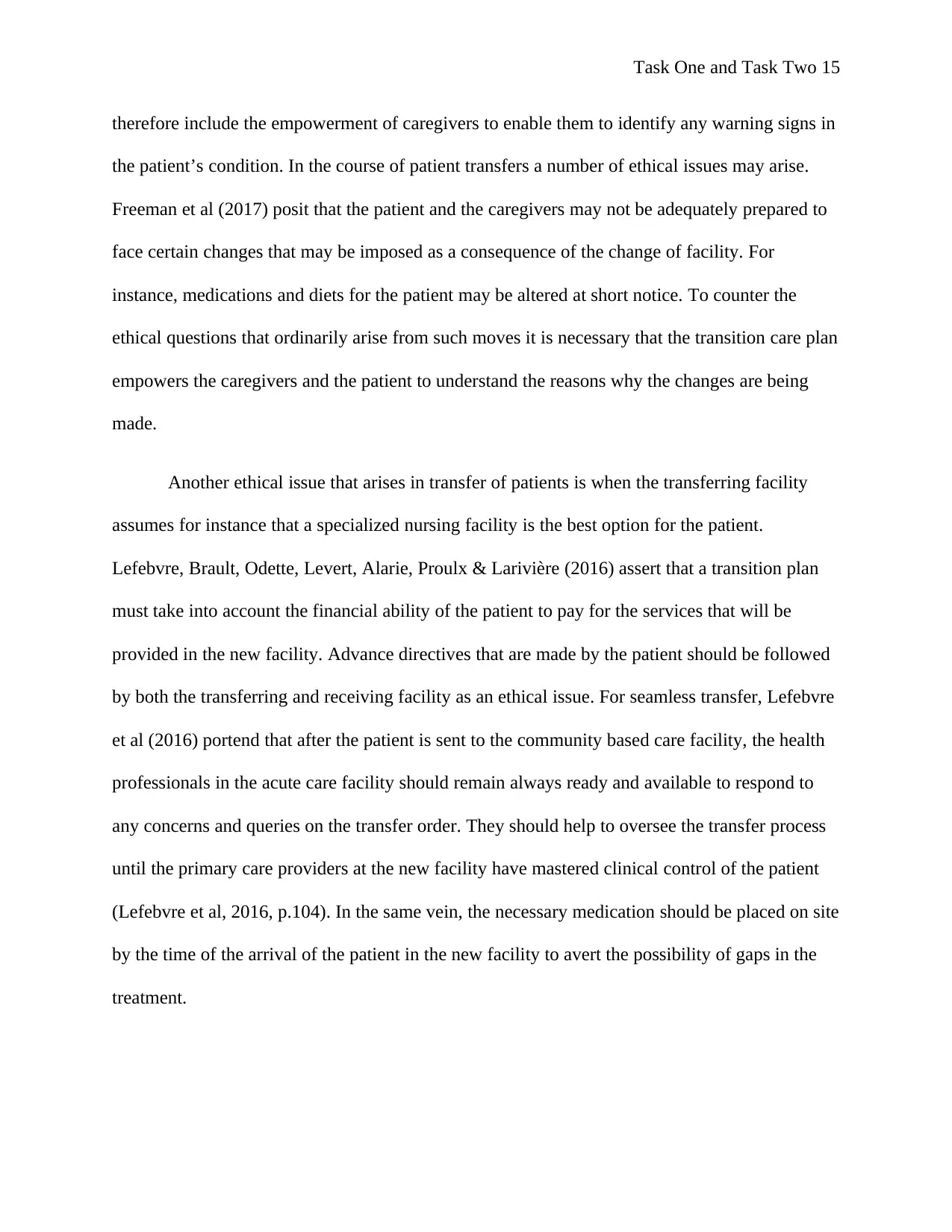
Task One and Task Two 15
therefore include the empowerment of caregivers to enable them to identify any warning signs in
the patient’s condition. In the course of patient transfers a number of ethical issues may arise.
Freeman et al (2017) posit that the patient and the caregivers may not be adequately prepared to
face certain changes that may be imposed as a consequence of the change of facility. For
instance, medications and diets for the patient may be altered at short notice. To counter the
ethical questions that ordinarily arise from such moves it is necessary that the transition care plan
empowers the caregivers and the patient to understand the reasons why the changes are being
made.
Another ethical issue that arises in transfer of patients is when the transferring facility
assumes for instance that a specialized nursing facility is the best option for the patient.
Lefebvre, Brault, Odette, Levert, Alarie, Proulx & Larivière (2016) assert that a transition plan
must take into account the financial ability of the patient to pay for the services that will be
provided in the new facility. Advance directives that are made by the patient should be followed
by both the transferring and receiving facility as an ethical issue. For seamless transfer, Lefebvre
et al (2016) portend that after the patient is sent to the community based care facility, the health
professionals in the acute care facility should remain always ready and available to respond to
any concerns and queries on the transfer order. They should help to oversee the transfer process
until the primary care providers at the new facility have mastered clinical control of the patient
(Lefebvre et al, 2016, p.104). In the same vein, the necessary medication should be placed on site
by the time of the arrival of the patient in the new facility to avert the possibility of gaps in the
treatment.
therefore include the empowerment of caregivers to enable them to identify any warning signs in
the patient’s condition. In the course of patient transfers a number of ethical issues may arise.
Freeman et al (2017) posit that the patient and the caregivers may not be adequately prepared to
face certain changes that may be imposed as a consequence of the change of facility. For
instance, medications and diets for the patient may be altered at short notice. To counter the
ethical questions that ordinarily arise from such moves it is necessary that the transition care plan
empowers the caregivers and the patient to understand the reasons why the changes are being
made.
Another ethical issue that arises in transfer of patients is when the transferring facility
assumes for instance that a specialized nursing facility is the best option for the patient.
Lefebvre, Brault, Odette, Levert, Alarie, Proulx & Larivière (2016) assert that a transition plan
must take into account the financial ability of the patient to pay for the services that will be
provided in the new facility. Advance directives that are made by the patient should be followed
by both the transferring and receiving facility as an ethical issue. For seamless transfer, Lefebvre
et al (2016) portend that after the patient is sent to the community based care facility, the health
professionals in the acute care facility should remain always ready and available to respond to
any concerns and queries on the transfer order. They should help to oversee the transfer process
until the primary care providers at the new facility have mastered clinical control of the patient
(Lefebvre et al, 2016, p.104). In the same vein, the necessary medication should be placed on site
by the time of the arrival of the patient in the new facility to avert the possibility of gaps in the
treatment.
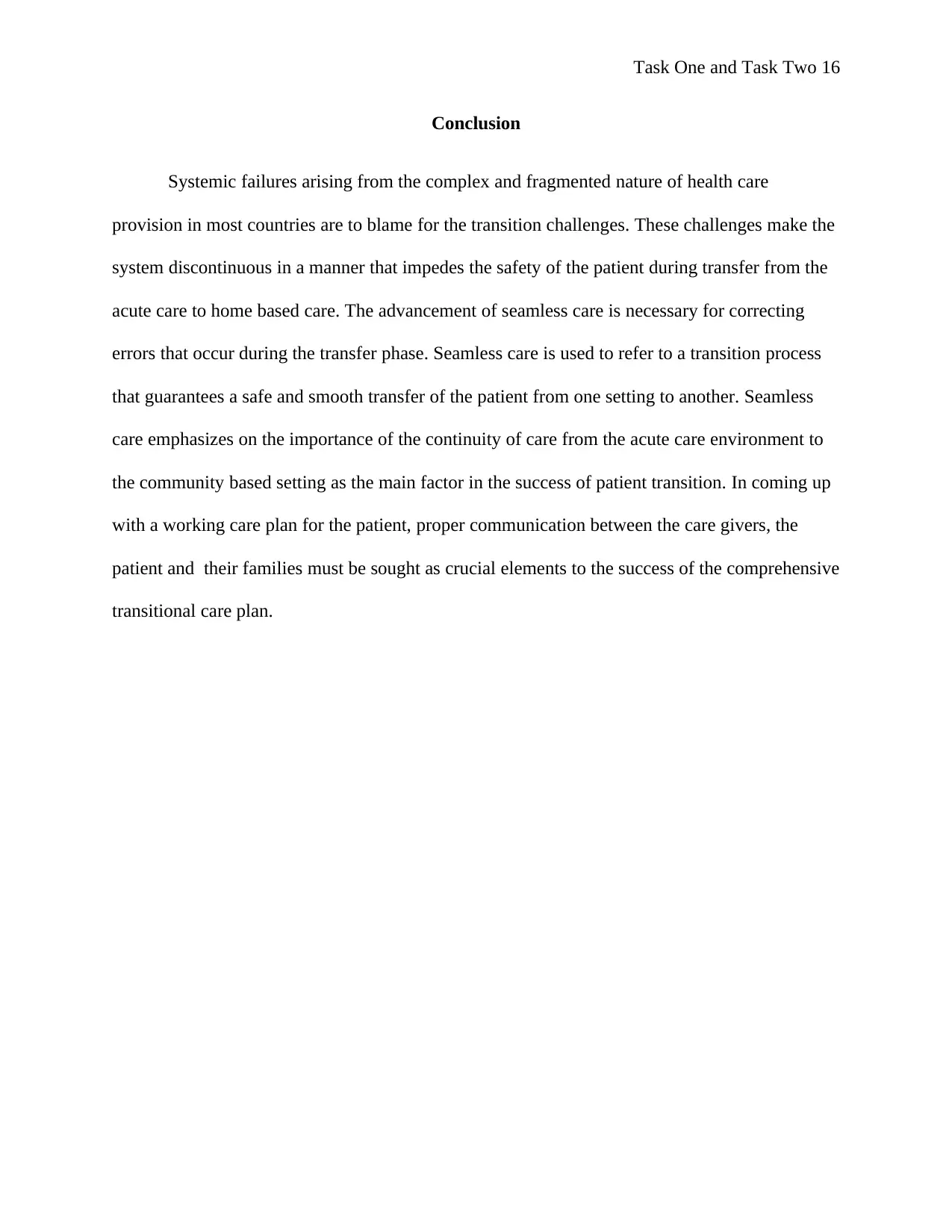
Task One and Task Two 16
Conclusion
Systemic failures arising from the complex and fragmented nature of health care
provision in most countries are to blame for the transition challenges. These challenges make the
system discontinuous in a manner that impedes the safety of the patient during transfer from the
acute care to home based care. The advancement of seamless care is necessary for correcting
errors that occur during the transfer phase. Seamless care is used to refer to a transition process
that guarantees a safe and smooth transfer of the patient from one setting to another. Seamless
care emphasizes on the importance of the continuity of care from the acute care environment to
the community based setting as the main factor in the success of patient transition. In coming up
with a working care plan for the patient, proper communication between the care givers, the
patient and their families must be sought as crucial elements to the success of the comprehensive
transitional care plan.
Conclusion
Systemic failures arising from the complex and fragmented nature of health care
provision in most countries are to blame for the transition challenges. These challenges make the
system discontinuous in a manner that impedes the safety of the patient during transfer from the
acute care to home based care. The advancement of seamless care is necessary for correcting
errors that occur during the transfer phase. Seamless care is used to refer to a transition process
that guarantees a safe and smooth transfer of the patient from one setting to another. Seamless
care emphasizes on the importance of the continuity of care from the acute care environment to
the community based setting as the main factor in the success of patient transition. In coming up
with a working care plan for the patient, proper communication between the care givers, the
patient and their families must be sought as crucial elements to the success of the comprehensive
transitional care plan.
Secure Best Marks with AI Grader
Need help grading? Try our AI Grader for instant feedback on your assignments.
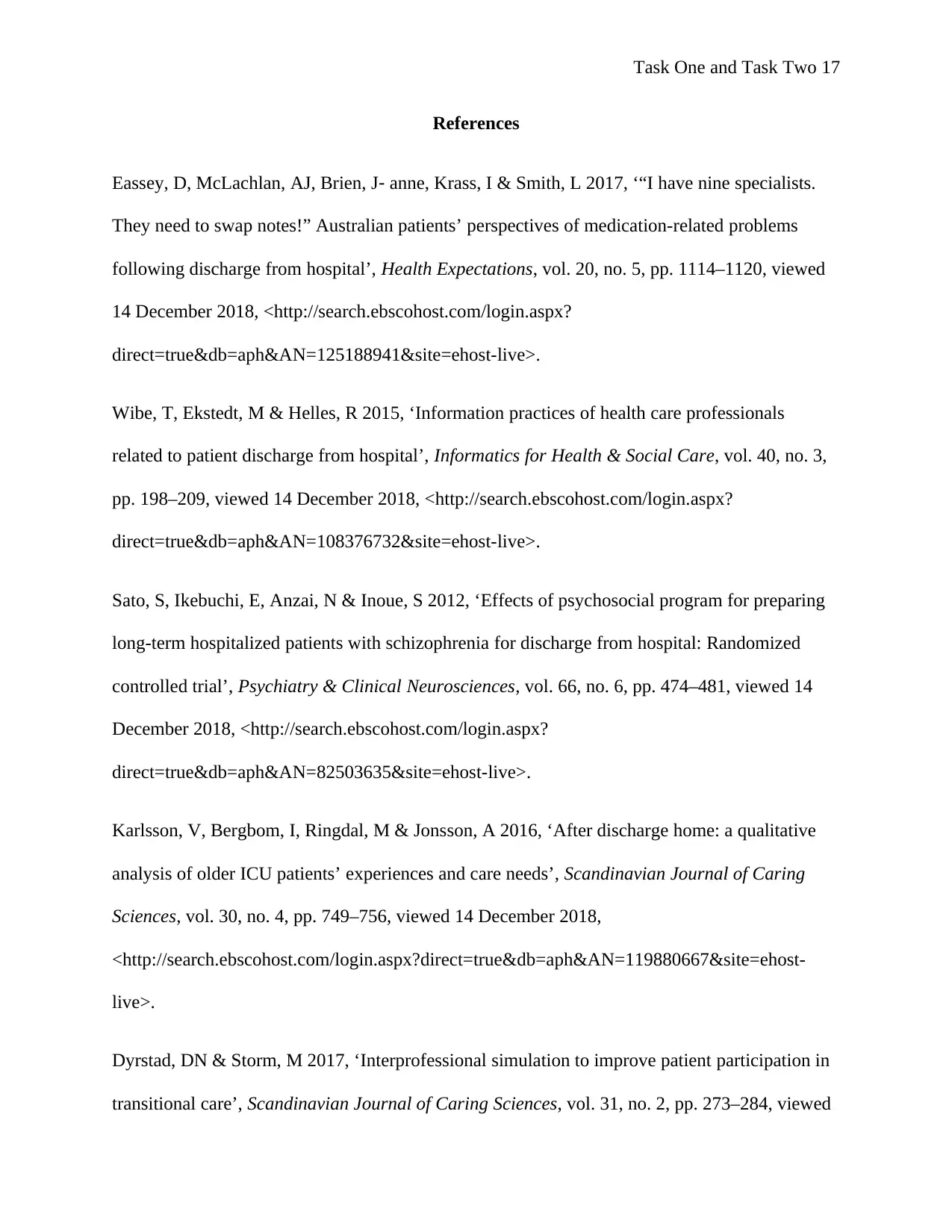
Task One and Task Two 17
References
Eassey, D, McLachlan, AJ, Brien, J‐ anne, Krass, I & Smith, L 2017, ‘“I have nine specialists.
They need to swap notes!” Australian patients’ perspectives of medication-related problems
following discharge from hospital’, Health Expectations, vol. 20, no. 5, pp. 1114–1120, viewed
14 December 2018, <http://search.ebscohost.com/login.aspx?
direct=true&db=aph&AN=125188941&site=ehost-live>.
Wibe, T, Ekstedt, M & Helles, R 2015, ‘Information practices of health care professionals
related to patient discharge from hospital’, Informatics for Health & Social Care, vol. 40, no. 3,
pp. 198–209, viewed 14 December 2018, <http://search.ebscohost.com/login.aspx?
direct=true&db=aph&AN=108376732&site=ehost-live>.
Sato, S, Ikebuchi, E, Anzai, N & Inoue, S 2012, ‘Effects of psychosocial program for preparing
long-term hospitalized patients with schizophrenia for discharge from hospital: Randomized
controlled trial’, Psychiatry & Clinical Neurosciences, vol. 66, no. 6, pp. 474–481, viewed 14
December 2018, <http://search.ebscohost.com/login.aspx?
direct=true&db=aph&AN=82503635&site=ehost-live>.
Karlsson, V, Bergbom, I, Ringdal, M & Jonsson, A 2016, ‘After discharge home: a qualitative
analysis of older ICU patients’ experiences and care needs’, Scandinavian Journal of Caring
Sciences, vol. 30, no. 4, pp. 749–756, viewed 14 December 2018,
<http://search.ebscohost.com/login.aspx?direct=true&db=aph&AN=119880667&site=ehost-
live>.
Dyrstad, DN & Storm, M 2017, ‘Interprofessional simulation to improve patient participation in
transitional care’, Scandinavian Journal of Caring Sciences, vol. 31, no. 2, pp. 273–284, viewed
References
Eassey, D, McLachlan, AJ, Brien, J‐ anne, Krass, I & Smith, L 2017, ‘“I have nine specialists.
They need to swap notes!” Australian patients’ perspectives of medication-related problems
following discharge from hospital’, Health Expectations, vol. 20, no. 5, pp. 1114–1120, viewed
14 December 2018, <http://search.ebscohost.com/login.aspx?
direct=true&db=aph&AN=125188941&site=ehost-live>.
Wibe, T, Ekstedt, M & Helles, R 2015, ‘Information practices of health care professionals
related to patient discharge from hospital’, Informatics for Health & Social Care, vol. 40, no. 3,
pp. 198–209, viewed 14 December 2018, <http://search.ebscohost.com/login.aspx?
direct=true&db=aph&AN=108376732&site=ehost-live>.
Sato, S, Ikebuchi, E, Anzai, N & Inoue, S 2012, ‘Effects of psychosocial program for preparing
long-term hospitalized patients with schizophrenia for discharge from hospital: Randomized
controlled trial’, Psychiatry & Clinical Neurosciences, vol. 66, no. 6, pp. 474–481, viewed 14
December 2018, <http://search.ebscohost.com/login.aspx?
direct=true&db=aph&AN=82503635&site=ehost-live>.
Karlsson, V, Bergbom, I, Ringdal, M & Jonsson, A 2016, ‘After discharge home: a qualitative
analysis of older ICU patients’ experiences and care needs’, Scandinavian Journal of Caring
Sciences, vol. 30, no. 4, pp. 749–756, viewed 14 December 2018,
<http://search.ebscohost.com/login.aspx?direct=true&db=aph&AN=119880667&site=ehost-
live>.
Dyrstad, DN & Storm, M 2017, ‘Interprofessional simulation to improve patient participation in
transitional care’, Scandinavian Journal of Caring Sciences, vol. 31, no. 2, pp. 273–284, viewed
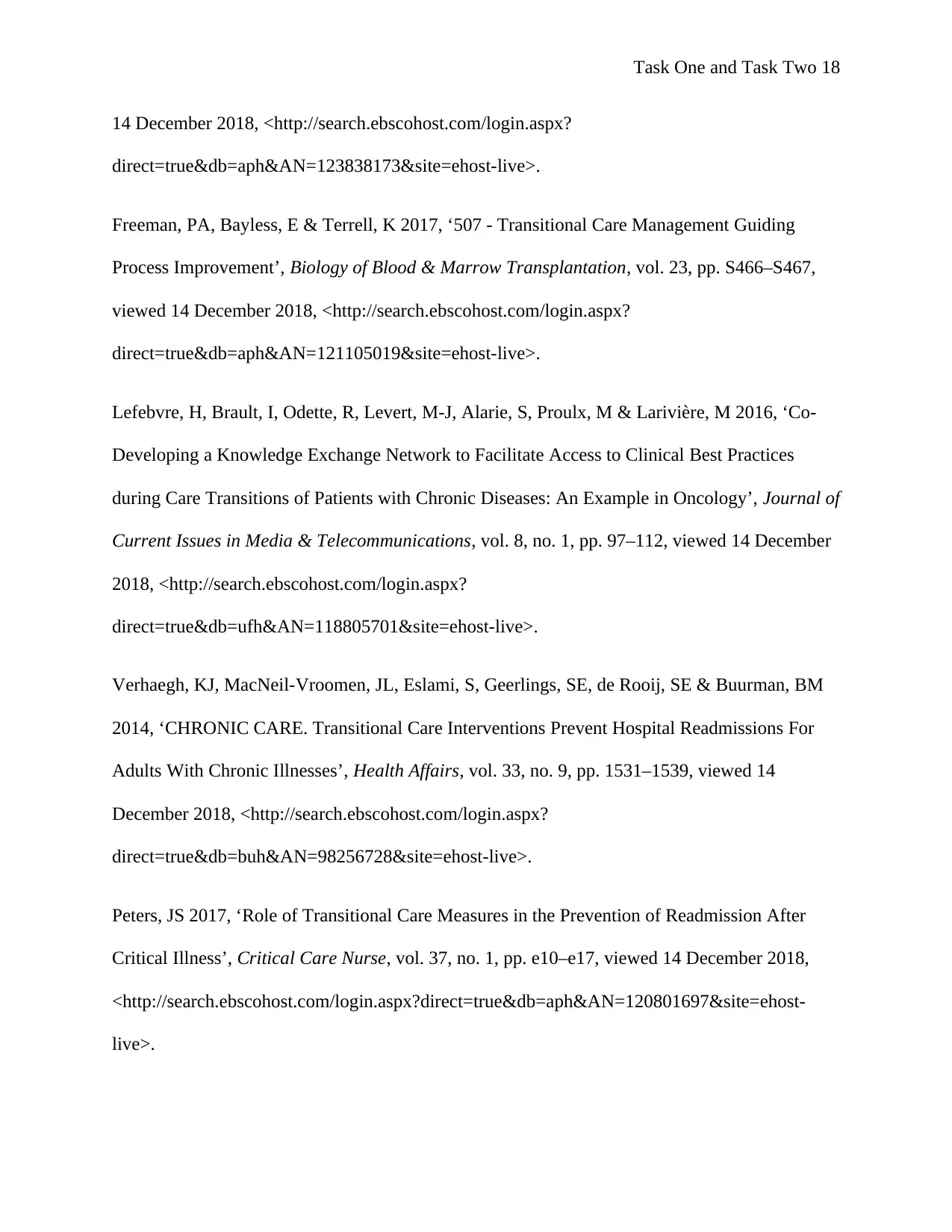
Task One and Task Two 18
14 December 2018, <http://search.ebscohost.com/login.aspx?
direct=true&db=aph&AN=123838173&site=ehost-live>.
Freeman, PA, Bayless, E & Terrell, K 2017, ‘507 - Transitional Care Management Guiding
Process Improvement’, Biology of Blood & Marrow Transplantation, vol. 23, pp. S466–S467,
viewed 14 December 2018, <http://search.ebscohost.com/login.aspx?
direct=true&db=aph&AN=121105019&site=ehost-live>.
Lefebvre, H, Brault, I, Odette, R, Levert, M-J, Alarie, S, Proulx, M & Larivière, M 2016, ‘Co-
Developing a Knowledge Exchange Network to Facilitate Access to Clinical Best Practices
during Care Transitions of Patients with Chronic Diseases: An Example in Oncology’, Journal of
Current Issues in Media & Telecommunications, vol. 8, no. 1, pp. 97–112, viewed 14 December
2018, <http://search.ebscohost.com/login.aspx?
direct=true&db=ufh&AN=118805701&site=ehost-live>.
Verhaegh, KJ, MacNeil-Vroomen, JL, Eslami, S, Geerlings, SE, de Rooij, SE & Buurman, BM
2014, ‘CHRONIC CARE. Transitional Care Interventions Prevent Hospital Readmissions For
Adults With Chronic Illnesses’, Health Affairs, vol. 33, no. 9, pp. 1531–1539, viewed 14
December 2018, <http://search.ebscohost.com/login.aspx?
direct=true&db=buh&AN=98256728&site=ehost-live>.
Peters, JS 2017, ‘Role of Transitional Care Measures in the Prevention of Readmission After
Critical Illness’, Critical Care Nurse, vol. 37, no. 1, pp. e10–e17, viewed 14 December 2018,
<http://search.ebscohost.com/login.aspx?direct=true&db=aph&AN=120801697&site=ehost-
live>.
14 December 2018, <http://search.ebscohost.com/login.aspx?
direct=true&db=aph&AN=123838173&site=ehost-live>.
Freeman, PA, Bayless, E & Terrell, K 2017, ‘507 - Transitional Care Management Guiding
Process Improvement’, Biology of Blood & Marrow Transplantation, vol. 23, pp. S466–S467,
viewed 14 December 2018, <http://search.ebscohost.com/login.aspx?
direct=true&db=aph&AN=121105019&site=ehost-live>.
Lefebvre, H, Brault, I, Odette, R, Levert, M-J, Alarie, S, Proulx, M & Larivière, M 2016, ‘Co-
Developing a Knowledge Exchange Network to Facilitate Access to Clinical Best Practices
during Care Transitions of Patients with Chronic Diseases: An Example in Oncology’, Journal of
Current Issues in Media & Telecommunications, vol. 8, no. 1, pp. 97–112, viewed 14 December
2018, <http://search.ebscohost.com/login.aspx?
direct=true&db=ufh&AN=118805701&site=ehost-live>.
Verhaegh, KJ, MacNeil-Vroomen, JL, Eslami, S, Geerlings, SE, de Rooij, SE & Buurman, BM
2014, ‘CHRONIC CARE. Transitional Care Interventions Prevent Hospital Readmissions For
Adults With Chronic Illnesses’, Health Affairs, vol. 33, no. 9, pp. 1531–1539, viewed 14
December 2018, <http://search.ebscohost.com/login.aspx?
direct=true&db=buh&AN=98256728&site=ehost-live>.
Peters, JS 2017, ‘Role of Transitional Care Measures in the Prevention of Readmission After
Critical Illness’, Critical Care Nurse, vol. 37, no. 1, pp. e10–e17, viewed 14 December 2018,
<http://search.ebscohost.com/login.aspx?direct=true&db=aph&AN=120801697&site=ehost-
live>.
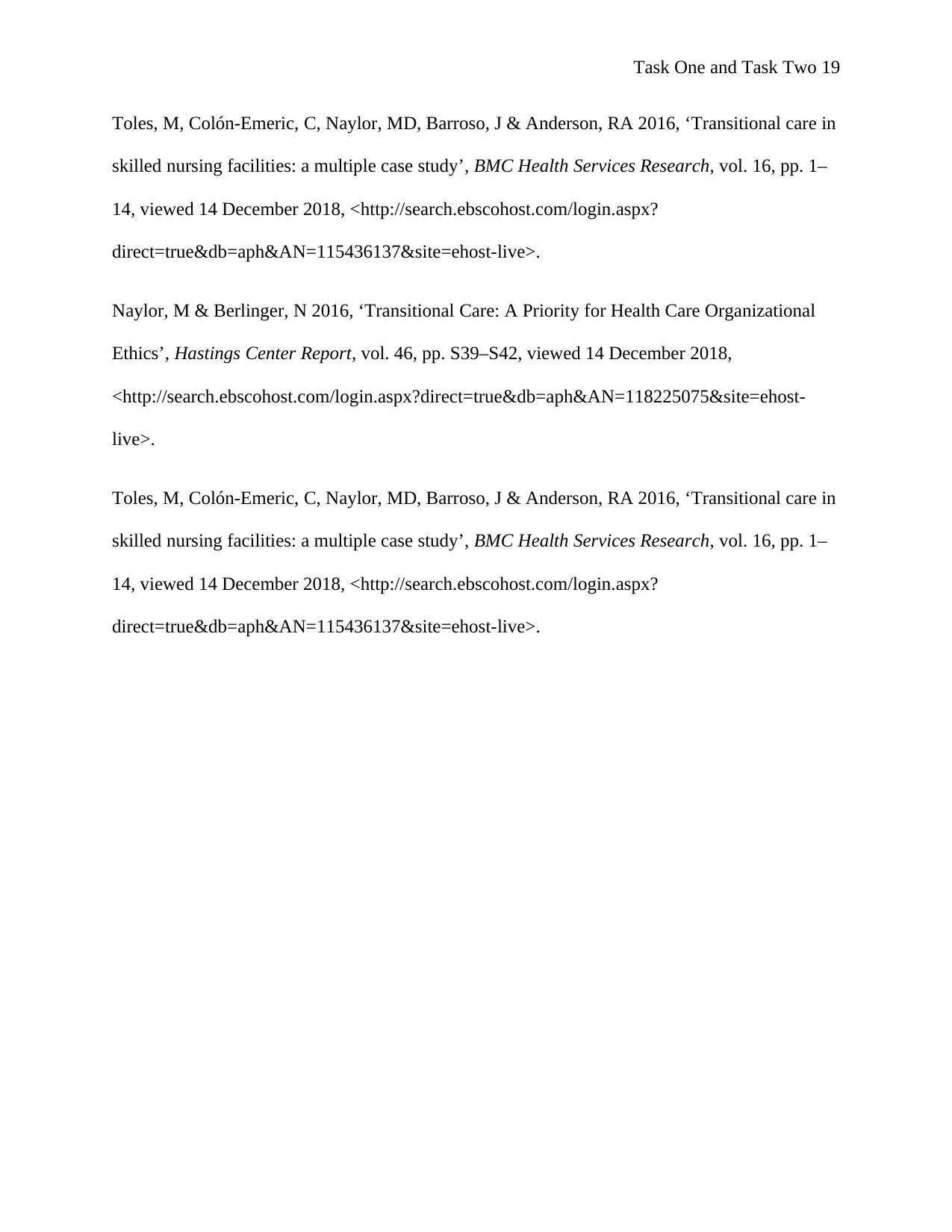
Task One and Task Two 19
Toles, M, Colón-Emeric, C, Naylor, MD, Barroso, J & Anderson, RA 2016, ‘Transitional care in
skilled nursing facilities: a multiple case study’, BMC Health Services Research, vol. 16, pp. 1–
14, viewed 14 December 2018, <http://search.ebscohost.com/login.aspx?
direct=true&db=aph&AN=115436137&site=ehost-live>.
Naylor, M & Berlinger, N 2016, ‘Transitional Care: A Priority for Health Care Organizational
Ethics’, Hastings Center Report, vol. 46, pp. S39–S42, viewed 14 December 2018,
<http://search.ebscohost.com/login.aspx?direct=true&db=aph&AN=118225075&site=ehost-
live>.
Toles, M, Colón-Emeric, C, Naylor, MD, Barroso, J & Anderson, RA 2016, ‘Transitional care in
skilled nursing facilities: a multiple case study’, BMC Health Services Research, vol. 16, pp. 1–
14, viewed 14 December 2018, <http://search.ebscohost.com/login.aspx?
direct=true&db=aph&AN=115436137&site=ehost-live>.
Toles, M, Colón-Emeric, C, Naylor, MD, Barroso, J & Anderson, RA 2016, ‘Transitional care in
skilled nursing facilities: a multiple case study’, BMC Health Services Research, vol. 16, pp. 1–
14, viewed 14 December 2018, <http://search.ebscohost.com/login.aspx?
direct=true&db=aph&AN=115436137&site=ehost-live>.
Naylor, M & Berlinger, N 2016, ‘Transitional Care: A Priority for Health Care Organizational
Ethics’, Hastings Center Report, vol. 46, pp. S39–S42, viewed 14 December 2018,
<http://search.ebscohost.com/login.aspx?direct=true&db=aph&AN=118225075&site=ehost-
live>.
Toles, M, Colón-Emeric, C, Naylor, MD, Barroso, J & Anderson, RA 2016, ‘Transitional care in
skilled nursing facilities: a multiple case study’, BMC Health Services Research, vol. 16, pp. 1–
14, viewed 14 December 2018, <http://search.ebscohost.com/login.aspx?
direct=true&db=aph&AN=115436137&site=ehost-live>.
1 out of 19
Related Documents
Your All-in-One AI-Powered Toolkit for Academic Success.
+13062052269
info@desklib.com
Available 24*7 on WhatsApp / Email
![[object Object]](/_next/static/media/star-bottom.7253800d.svg)
Unlock your academic potential
© 2024 | Zucol Services PVT LTD | All rights reserved.





